|
4/24/2023 Stagecoaches Through ActonOur document collection contains a way bill listing passengers who rode a stagecoach from Boston on Saturday, Dec. 2, 1843. Among the passengers was Mr. Noyes who caught the coach at “Earl House” and headed to Acton. The document is a souvenir of travel just before Acton’s transportation choices changed dramatically. Prior to the arrival of the Fitchburg Railroad in 1844, as Fletcher’s Acton in History tells us, travel to and from Boston “was slow and difficult. The country trader’s merchandise had to be hauled by means of ox or horse-teams from the city. Lines of stage-coaches indeed radiated in all directions from the city for the conveyance of passengers, but so much time was consumed in going and returning by this conveyance that a stop over night was absolutely necessary if any business was to be done. ... a visit to Boston before the era of the railroad was something to be planned as a matter of serious concern. All the internal commerce between city and country necessitated stage-coaches and teams of every description, and on all the main lines of road might be seen long lines of four and eight-horse teams conveying merchandise to and from the city. As a matter of necessity, taverns and hostelries were numerous and generally well patronized.” (p. 268) Coaches required fresh teams of horses at intervals, so stops were usually made every 8-12 miles. Acton had taverns before the stage routes (for example Mark White’s at 274 Great Road and Jones Tavern in South Acton), but as stage travel became more prevalent, taverns and inns multiplied as well. Shattuck’s History of Concord says that the first public stagecoaches came from Boston “into the country through Concord, in 1791, by Messrs. John Vose & Co.” (p. 205) Ads for stages between Boston “and the country north-west thereof” were being advertised in the Columbian Centinel in 1793, leaving from Charlestown and passing through Concord and Groton. Acton was not mentioned specifically, but presumably stages traveled via today’s Great Road, coming from Concord, through East Acton, by Nagog Pond, and on into Littleton. That route was noted as “Littleton Road” on a map drawn by Jabez Brown in 1794 and was also in early days referred to as the Groton Road. Like later decisions about railroad routes, decisions made elsewhere about stage and mail routes would have significant effects on businesses in outlying towns. The Columbian Centinel ran a series of proposals in 1794 that indicated that the mail route from Boston to Keene and other points in New Hampshire had not yet been settled. It would either go through Concord and Lancaster or Concord and Groton. Later, there seem to have been disputes among “interested persons” such as innkeepers about whether there was a significant difference in distance between the Groton-to-Lexington routes via Carlisle or Concord. (Green’s Historical Sketch, p. 193) By June 1810, the Boston Patriot was running ads for competing stage lines that explicitly mentioned Acton. Luther Carlton advertised the Concord, Harvard & Winchendon Stage that left Boston on Wednesdays & Saturdays at 7 a.m., passing through West Cambridge, Lexington, Concord, Acton, Boxborough, Harvard, Shirley, Lunenburg, and Fitchburg. (On Saturdays, it continued on to Ashburnham and Winchendon.) Return trips were on Mondays and Fridays. (June 23, p. 4) Meanwhile, a “new Arrangement of the old Concord and Leominster MAIL STAGE” was leaving Boston on Tuesdays, Thursdays and Saturdays at 5 a.m. going through Cambridge, West Cambridge, Lexington, North Lincoln, Concord, South Acton, Stow, Bolton, Lancaster, Leominster, South Fitchburg, Westminster, Gardner, Templeton, Gerry and Athol. The return stage left Athol at 4 a.m. on Monday, Wednesday and Friday, arriving in Boston in the evening. The latter ad noted that the meal stop was at the Hotel in Concord. (June 2, p. 4) On March 16, 1827, the Boston Traveler advertised that the Boston and Keene Union Stage Company ran a daily stage line leaving Boston at 5 a. m., passing through Lexington, Concord, Acton, Groton, Townsend, Ashby, Rindge (NH), Fitzwilliam (NH), Troy (NH), and Keene (NH), arriving at 5 p.m. in Charlestown (NH). Connections from Keene and Charlestown allowed travelers to continue on to points in Vermont, New Hampshire, and Saratoga Springs. “The Company have been to great expense in purchasing the best of horses and carriages and employing the most careful and obliging drivers, and have spared no pains in establishing the line that it shall not be exceeded by any other from Boston for dispatch and convenience of passengers. They have fourteen changes of teams between Boston and Charlestown, giving only about eight miles for each set of horses.” (p. 3) Stage coach stops such as those advertised by the Union Stage Company encouraged the growth of taverns and inns. Fletcher tells us that “in the east part of Acton, on the road leading from Boston to Keene, there were no less than four or five houses of public entertainment.” (p. 268) An 1831 map shows “Weatherbee’s” (65 Great Road), “Hatgood’s” (really Hapgood’s at 162 Great Road) and White’s (514 Great Road) taverns along Groton Road. The earlier White’s Tavern had been opened in 1755 and operated for a number of years, but it was not in operation in 1831. Fletcher’s History also notes that additional demand for taverns was from drovers who would accompany livestock to their summering pastures in New Hampshire. Wetherbee’s Tavern was well-known to drovers and drivers of baggage-wagons all the way to Canada. (Fletcher, p. 294) 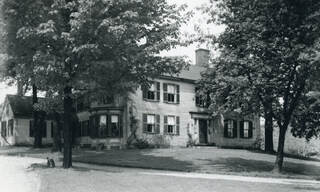 Hosmer Tavern, 471 Mass. Ave., c. 1930s-1940s Hosmer Tavern, 471 Mass. Ave., c. 1930s-1940s Another stage route through Acton followed the Union Turnpike, although as originally surveyed, it had some steep grades farther west that were not popular with stage coach drivers. During the cash-strapped post-Revolutionary War years, the expansion of long-distance roads was often accomplished by for-profit ventures that would involve building a road and then collecting tolls, often at bridges. The Union Turnpike was approved by the Massachusetts Legislature in March 1804 and started operating in 1809. Joel Hosmer of Acton, seeing a business opportunity, enlarged his father’s house at 471 Massachusetts Avenue along the Union Turnpike route to serve as a tavern. (Joel Hosmer appears as one of the names attached to the Union Turnpike Corporation in the legislative act that established it.) The History of Harvard tells us that once Harvard got its own post office around 1811, the Harvard, Lunenburg and Winchendon stage would come with mail and passengers from Concord over the Union Turnpike. Those coaches would stop at a tavern in Harvard (the half-way point) for meals. Hosmer’s Tavern, like the Turnpike itself, was not a profitable venture. The Union Turnpike’s competitor route, the Lancaster and Bolton Turnpike, had easier grades. After the Union Turnpike’s bridge in Harvard was swept away by flooding in 1818, it was not rebuilt. The overly-steep grades were eventually abandoned and what was left of the turnpike in Middlesex County became a public road in 1830. Today, Acton’s Massachusetts Avenue (Route 111) follows the route of the old turnpike. During the 1830s, changes in transportation were happening elsewhere, but coaches kept running through Acton. The Daily Evening Transcript on Sept. 2, 1833 advertised the Lunenburg & Boston Mail Stage, leaving Boston on Tuesdays, Thursdays and Saturdays at 8 a. m., arriving in Lunenburg at 4 p.m., passing through Cambridge, Concord, Acton, Harvard, Still River Village, Shirley Village, and Shirley. One could buy tickets at Brigham’s, 42 Hanover Street, from proprietor William Shepherd. The Bay State Democrat ran an ad on June 3, 1840 for a new line of post coaches to Harvard, MA that would go from 9 Court Street, Boston, via Cambridge, West Cambridge, Lexington, Bedford, Concord, Acton and Boxboro on Tuesdays, Thursdays and Saturdays. The Worcester Palladium advertised on March 31, 1841 proposed (presumably mail) routes, for two-horse coaches. The first was from Concord to Shirley by way of Acton, Boxboro and Harvard, 18 miles in four hours (Tuesday, Thursday and Saturday, to leave at 2 p.m.). The return trip was to leave Shirley on Monday, Wednesday and Friday at 7 a.m. The second route was from Worcester to Lowell, going through Boylston, Berlin, Feltonville, Stow, Acton and Chelmsford. We found no further information on the latter route. In terms of time and place, the ad most relevant to our way bill was found in the March 24, 1843 Boston Traveler. U.S. Mail Coaches would start out from Boston at 10 A. M., leaving from the office at 9 Court Street and 36 Hanover Street on Tuesdays, Thursdays, and Saturdays for Lexington, Concord, Acton, Boxboro, Harvard, Shirley Village and Leominster Village. The return trip was from Harvard at 9 A. M. Mondays, Wednesdays, and Fridays. Our way bill was a Saturday run with 12 passengers (including some children). Mr. Noyes left for Acton from Earl House, listed in the 1842 Boston Almanac as Earl’s Coffee House, operating at 36 Hanover Street. The driver, P. Harrington, may have been Phineas Harrington who, according to Samuel A. Green’s Groton history, had a long career as a stage coach driver in the area. By the time Mr. Noyes took his trip to Acton in Dec. 1843, transportation patterns were changing. Railroads were already providing an alternative to stagecoaches elsewhere. The Fitchburg Railroad was completed to West Acton in the autumn of 1844, and Fletcher says, “that village became a distributing point for the delivery of goods destined for more remote points.” (p. 268) An ad from the Boston Courier on Oct. 28, 1844 tells us that “down trains” to Charlestown would leave West Acton at 7:36 and 10:51 am and around 5 p.m. Trains from Charlestown would leave at 8 a.m. and 1 and 4:30 p.m. After the 8 a.m. train arrived in Acton, stages would leave from there every day except Sunday for “Littleton, Groton, Townsend, Lunenburg, Fitchburg, Ashburnham, Winchendon, Westminster, South Gardner, Templeton, Phillipston, Athol, Mass.; Fitzwilliam, Troy, Swansey, Keene, Walpole, Charlestown, N. H.; Chester, Windsor, Woodstock, Rutland, Middlebury, Royalton, Montpelier, and Burlington, Vt.” There were other stages that only traveled three days per week for points in western Massachusetts, New Hampshire, Vermont, as well as Albany, NY. After the first train arrived in Acton just after 11 a.m., stages would leave for “Stow, Boxboro’, Bolton, Harvard, Lancaster, Leominster and Fitchburg” on Tuesdays, Thursdays, and Saturdays, and for Littleton and Groton on Mondays, Wednesdays and Fridays. As the railroad was extended and lines proliferated, transportation patterns changed rapidly. Both South and West Acton kept growing thanks to the railroad, but Acton was only a stage hub for so many other destinations for a short time. Eventually, stagecoaches became a thing of the past. We are lucky to have in our archives a tangible reminder of those earlier days. Sources:
We are also grateful to the following websites for sharing information and sources on stage routes in other towns (all accessed April 23, 2023): Ella Miller’s five-year diaries at our Society give us an idea of what life was like for a career Acton schoolteacher at the beginning of the twentieth century. An issue that Ella mentioned often was the complications she faced in getting to and from work. As mentioned in our previous blog post, Ella’s earliest teaching job would have presented few commuting problems. After graduation from Framingham Normal School in the spring of 1896, she started teaching that fall in the same schoolhouse that she had attended in North Acton around the corner from her home. Ella’s time teaching in North Acton was the end of an era. One-room schoolhouses were being consolidated into larger schools. In the fall of 1899, Ella and the students from North Acton were sent to the “Centre” school on Meetinghouse Hill, following the East Acton school that had been closed in 1897. Southeastern Acton students were sent to the South Acton school the year before that. The idea behind the consolidations was that they would improve students’ educational experience by reducing the number of grades a teacher needed to handle. Ella became teacher of the Center school’s intermediate students, with grades 4-6 in her classroom. The move to the Center School, while it may have reduced Ella’s in-classroom complications, added complexity to her travels to and from her North Acton home. The distance was a little less than two miles, by today’s standards a miraculously short commute. In Ella’s day, those miles could be a challenge. Though she lived near train tracks, the trains, even if they came through at the right time, did not go to Acton center. Ella, who would at the diaries’ beginning have been dressed in a long skirt and wearing a corset, found various ways to get to her job. There were days in all seasons when she would walk, either because of nice weather or lack of other options. On some days, she bicycled, and on others, her father gave her a ride in a horse-drawn vehicle. Without weather forecasts, there would have been plenty of room for error. On some days, she optimistically took her “wheel” to school, only to be faced with rain in the afternoon. Even if her father hitched up a horse and took her to work, there were factors to consider. Was there mud, ice, or snow to deal with? Occasionally Ella would mention that the conditions were “so slippery and horse smooth” that the going was extremely difficult; the horse’s shoes had to match road conditions. There was also an important decision to make about whether to take a wheeled vehicle or use “runners” for going over snow. Once choices were made, occasional mishaps were inevitable. In Jan. 1909, she reported that she had gone to school in the sleigh, but the going was rough. On one memorable day in Feb. 1911, a man who sometimes worked on the Miller farm took Ella in the sleigh. En route, “a runner broke & lowered my side to the ground. Came back and went in the wagon.” The following day, the sleigh went to the blacksmith’s shop. The Millers put their “democrat” wagon on runners, and after that it was “fine sleighing.” As snow receded, road conditions were variable and a real challenge. She walked home on Feb. 26 and 27, 1914 and said “Rather hard walking because snow is getting soft & makes it slumpy.” Then came mud season. On March 8, 1912, Ella wrote “Getting muddy but snow lingers in patches, slippery in shady places on the road.” On March 31, 1918, she wrote “A bad mud spot for autos just north of the house. Pa had to help Mr. Park of Chelmsford out with the horse & warned others.” The following March, Ella noted that there was “an auto stuck in the mud for 2 hours out here toward dusk.” Sometimes, other people made the roads even worse. In December 1914, Ella noted that “The trucks carrying Halls’ logs are making bad work of the roads, especially down beyond Hollowells”. When, finally, the roads dried up, Ella could ride her bicycle to school. Ella would note in her diary when she took her first spring ride. Not surprisingly, she would occasionally have issues with her bicycle. The second day of school in September 1908, her pedal came off, and there were inevitable problems with wheels and tires. Her neighbor Elmer Cheney often helped her with repairs, putting in a new valve or adding “Neverleak” to a tire. Sometimes if it rained after school, she would ride home anyway. She was a hardy person, but even she mentioned at the end of October 1914 that she’d gotten chilled coming home on her bicycle. (There was a little snow that morning, and it reached 33 degrees at night). She must have been particularly determined (or desperate) on Dec. 2, 1918 when she rode her bicycle at 16 degrees. The one option that Ella had for public transportation was to take the “barge” that the town provided for students from outlying areas to get to school. The barge was horse-drawn and provided (some) protection from the weather. Ella seems to have made a practice of taking the barge only when it was particularly needed. She mentioned conditions that induced her to take the barge; muddy roads, rain, thunder and high wind, sub-zero temperatures, a major snowstorm, and her family horse being lame. On May 11, 1917 she wrote that she “came home in barge every night, partly because of ironing, cooking, weather & Aunt Eliza being here.” Riding the barge was not a perfect commuting solution. The barge drivers had the same issues with deciding between wheels and runners as did the Millers. Some days were tough going. Children’s absences were often blamed on late barges, but Ella couldn’t afford to be late. On March 6, 1923, Ella reported that the “East Acton school barge tipped over yesterday morning on the way to school and several children had slight bruises.” There were also occasional behavioral incidents during the trips. On Feb. 8, 1912, Superintendent Hill came to school at Ella’s request to talk with a student “about his immoral language in the barge.” On December 15, 1921, Ella reported “Trouble in the North Acton barge going home last night – Boys pounding Kathleen so she didn’t come to school.” That incident led to another superintendent’s visit. By the 1910s, some people in Ella’s acquaintance had bought automobiles. Superintendents in early days covered multiple towns. In 1910, superintendent Frank Hill supervised Acton, Littleton and Westford. The 1911 reorganization of the district to include Carlisle seems to have become too much, and Mr. Hill started making his trek by auto. In April 1915, Ella’s co-teacher and friend Martha Smith got an automobile. In the later 1910s, Ella would sometimes get rides get rides from Miss Smith and others. Over the years of Ella’s diaries, it is interesting to note that while some, like the Smiths, started traveling by auto, the horse remained the means of transportation for many. As late as January 1926, Ella noted that it was icy for autos that morning, so “Pa got horse sharpened.” Even though cars would have solved many commuting problems, they added their own as well. In 1917, Ella mentioned that “Miss Smith wrenched her back cranking auto last night. Feeling mean but came to school.” (Mean was Ella’s term for sick or sore.) On two other occasions, Ella mentioned men breaking an arm while cranking their automobiles. Other teachers had their own commuting issues. Those who were living in other towns might rely on trains. Ella noted in Dec. 1917 that Miss Barrett had not gotten to school until 9 o’clock because her train was late and she missed the barge at East Acton. Ella’s father picked her up with horse power. Miss Durkee, an hour late in March 1920, had resorted to snowshoes to get to school. Whatever the mode of transportation, the condition of the roads mattered. Ella occasionally mentioned men working on the road, macadamizing (putting down gravel) or tarring. Snow clearing was a perpetual problem. In Feb. 1920, a storm dropped so much snow that men including Ella’s father shoveled the road by hand to make it wide enough for an auto. Later that week, Ella mentioned her father shoveling the North Acton driveway where drifts were four feet deep. A particularly memorable road issue was caused by the Freeman family in 1914. On Sept. 6, Ella reported that Mr. Freeman had bought a little house and was going to move it onto Ruth Robbins’ North Acton land. At various times in October, Ella would mention which part of the road was affected that day. On Oct. 8, Ella mentioned that it was right across the road that evening. A week later, it was half way to the brook. On the 19th, “Freeman’s house is at the brook, so we go by through the brook.” The next day, “Freeman’s house was almost at the corner so we could go around the triangle.” On Sunday the 25th, “The autos have been very thick by here today & yesterday afternoon because Freeman’s house still blocks the state road.” Presumably the house reached its destination soon thereafter, because the traffic reports stopped. 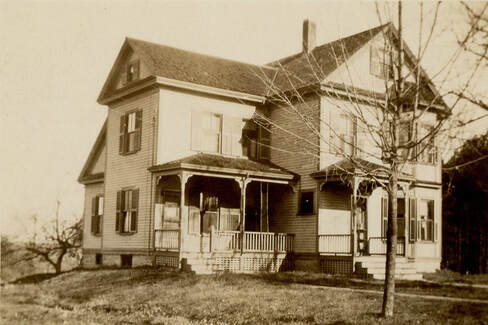 Miller Home, 32 Concord Road Miller Home, 32 Concord Road A New Commute, Twice In 1919, Ella’s mother passed away. It was time for a change. Ella bought a house just outside the center at 32 Concord Road. For a while, the family went “down home” to the farm periodically. There was a time when the property was rented, but eventually a buyer was found. The move to Concord Road would have made Ella’s commuting to the Center School considerably easier. Snowy days were still a problem, of course. In January 1923, Ella tried skiing and liked it enough to buy skis of her own. She used them occasionally to get to work on days such as Jan. 15, 1923 when it was snowing hard and the barges had difficulty getting through. She learned later that winter that skis might not be so useful for getting home if the snow had softened up. The horse-drawn school barges were replaced by school busses in the fall of 1923. In the winter of 1924 and 1925, Ella mentioned that the busses had trouble getting through snow-filled roads and brought the children over an hour late. In Jan. 1925, a bus got stuck on “Pope’s Road” and didn’t deliver the last children home until 6:30 pm. Ella never mentioned missing the old sleighs in the winter, but it might have occurred to her. Ironically, after moving closer to her work, Ella’s commute became longer again in 1926. After years of contention (see blog post), Acton finally had managed to agree to build a high school that opened up at Kelley’s corner on January 11, 1926. On March 1, 1926, the 7th grade went to that building with Ella as their teacher. Ella’s father borrowed the Smiths’ horse and took her to school that day. On the 10th and the 15th, Ella mentioned that the roads were slippery for the horse to cope with. On the 18th, a neighbor gave Pa some “never-slip” shoes for the horse that were put on by the blacksmith. Ella’s sister Loraine gave her a ride to and from work on the 16th, and that may have convinced Ella to buy her own car on the 20th, a Ford coupe (known to us as a Model T). Driving lessons followed from friends and her sister. Ella mentioned learning to back up and turn around in the field below the cemetery and practicing turning around “up on edge of Boxboro, at Mr. Tenney’s, Miss Conant’s, Taylor’s store & schoolyard.” Her father continued taking her by horsepower, but as the new school year began, on Sept. 7, 1926, Ella wrote that she began going back and forth in her own car. The freedom must have been welcome, although later entries showed that Ella started having familiar-sounding problems. As cold weather arrived, her car wouldn’t start. She got chains for her tires and needed repeated charges for her battery. Water, alcohol and glycerin were put into the radiator and taken out again. On one ride, she noticed her steering wheel wobbling badly. At other times, her foot pedals needed adjusting, and there were issues with her generator. At the beginning of the next school year she reported, “Had a new experience with the car – couldn’t start it without pushing because something locked.” That was soon followed by “Had the brakes + lights on my car tested by Harold Coughlin. One headlight was not working – a surprise to me.” In October, after a teachers’ meeting, Ella had to ask the superintendent to crank her car, not an ideal work situation. We are missing Ella’s 1928-1932 diary, so we don’t know many of the details from those years. Driving must not have been a perfect solution for Ella. We learned from the Superintendent’s annual report that Ella moved back to the Center school, “nearer her home” in the fall of 1931. A relative newcomer, the superintendent reported that “at Acton Centre all teachers are new to the building,” which must have amused Ella after her many years there. She became principal of the Center school, and Marion Towne took over the seventh grade in the high school building. By the time Ella was writing in her final diary, 1933-1935, she made a practice of not registering her car until April. She would find other ways to get to school in the winter months. (She did mention that the weather would have allowed her to take the car to school every day in January 1933 if it had been registered.) By March 1933, signs of her failing health were beginning to show. Ella, who had amazing energy in her younger days, mentioned that she was getting winded walking to and from school. Mr. Fobes started transporting her, for which she was grateful. Ella continued to drive in better weather. Two of Ella’s final diary entries related to her car. On May 16, 1935, she got an oil change and the next day she wrote “All in tonight. Managed to take car to W. Acton by appointment & left to be tested and brakes relined & for them to bring home.” Sadly, that seems to have been her last excursion. By then, her heart was apparently giving out. Her diary entries stopped on May 25, and, as her sister Loraine noted in the diary later, “Ella’s work ended” on June 4. The Centre Grammar School was closed during part of the next day so that her pupils could attend her funeral. At age 57, she had been the oldest and the longest-serving teacher in Acton. 1/20/2023 Ella Lizzie Miller, Acton DiaristAs mentioned in our previous blog post, diaries can be a wonderful source of information about Acton in former days. At the Society’s Jenks Library, we are lucky to have a set of five-year diaries starting in 1908 kept by Ella Lizzie Miller, an Acton native who spent her nearly 39-year career teaching in Acton’s schools. Miller descendants have been very generous over the years, supplying our Society not only with Ella’s diaries, but with pictures, postcards, letters, memoirs, autograph books, and other items from the Miller family’s years in town. Before delving into the diaries, it seemed worthwhile to do some background research on Ella’s early life and her family. Ella Lizzie Miller was the eldest child of Charles Isaac Miller and Lucy Elizabeth Keyes. Charles was born on Aug. 24, 1850 in Sudbury, Vermont. His father Samuel Cooley Miller died in 1852 of sepsis from a cut on his finger. The 1860 census shows Charles living with his mother, his Miller grandmother, and two siblings in Sudbury, VT. In April 1871, Charles was (supposedly temporarily) working as a brakeman for the Northern Railroad, coupling railroad cars of a freight train at Canaan, NH. His right arm got caught, and his arm had to be amputated above the elbow. Newspapers reported details of the accident but also that employees of the railroad presented him with a gift of $91.50. Charles came to North Acton in 1873, around the time that the Nashua & Acton Railroad connected to the very sparsely-populated North Acton, branching off from the Framingham and Lowell that had arrived in 1871. Charles became the North Acton depot master, also serving as telegraph operator, switchman, and signal tender. According to Phalen’s history of Acton he “was so adept at handling freight and express with (his) attached hook that he was ever a marvel to the youngsters of the town.” (page 216) In January 1876, Charles bought from Daniel Harris ten acres between the Framingham and Lowell Railroad and the main road. That July, he bought an additional thirteen acres that went from the “Road to Lowell” (approximately #737 on today’s Main Street) to the “Mill Brook” (Nashoba Brook). The Framingham and Lowell Railroad ran through the land. The thirteen acres had once belonged to Aaron Woods and had been sold at auction the year before. (Aaron Woods' unsought fame was the subject of a previous blog post.) Ella Miller’s mother was Lucy Elizabeth (“Lizzie”) Keyes, born March 22, 1856 in Westford, MA. Her father Edward Keyes had died in South Carolina in August 1865, having served in the Union army for four years. For a while, Lizzie and her mother Lucy Ann (Robinson) lived in Groton with Lizzie’s grandmother. On May 23, 1872, Lizzie’s mother married Acton’s Isaac Train Flagg. Lizzie’s half-sister Edith Flagg was born March 11, 1875, and though Edith became Ella’s aunt, she really was her contemporary. According to family records, Charles Miller married Lucy “Lizzie” Keyes on Thanksgiving Day, Nov. 30, 1876 in North Acton. Four children followed: Ella Lizzie born Sept. 26, 1877, Alice Emma born March 10, 1879, Samuel Elmore born Nov. 25, 1881, and Loraine Esther born Nov. 6, 1884. Ella and her siblings grew up on the farm with the railroad running through their land behind the house, the depot just below, and the North Acton schoolhouse around the corner. The road in front led from Acton Center to Lowell. If Ella kept diaries as a young woman, unfortunately they did not find their way to our Society. We have had to use other sources to put together her early life. She attended the white schoolhouse on what is now Harris Street. A picture from between 1888 and 1890 shows her and Blanche Varney as the oldest of the students taught in the building by Miss Jessie Jones. The Concord Enterprise gives us glimpses of Ella’s later academic career. In 1890, she was one of 22 students (only 2 from North Acton) who were admitted to the relatively new High School program. She became the managing (and inaugural) editor of the school literary magazine "The Actonian." Ella was one of five students who graduated in June 1894. At the ceremony, she was selected to give an address entitled “Oars and Sails.” Town reports show that Ella L. Miller, while a member of the high school’s senior class, served as an assistant teacher in the South Primary School in Spring 1894. The School Committee’s annual report noted that “during the spring we were obliged, by the large number of pupils in attendance, to employ an assistant teacher and this assistant was compelled to take her classes into a corner of the schoolroom or to the cloak room, or the hallway, as the weather permitted.” (page 56) The hallways presumably would not have been heated. It was certainly an introduction to teaching with constrained resources. Ella and fellow graduate Blanche Varney passed the entrance examination for Framingham Normal School, a teachers’ training college. This was particularly important because as late as the 1897-1898 school year, the Superintendent’s report noted that Acton’s high school was not approved by the State Board of Education. The 1890s were a time when the state and the towns were struggling with what constituted a legitimate high school, with issues such as the minimum number of teachers, years of study, and curriculum. Ella’s autograph book, in possession of the Society, shows that she was originally a member of the Class of 1893, but in 1893, the high school course was changed to four years, and apparently Ella was one of the few who continued on. Ella graduated from Framingham Normal School in 1896. Ella was paid for teaching the North Acton school in the fall and winter of the 1896-1897 school year, taking over after the resignation of Lillian Richardson. Ella taught there for the next two years at a salary of $10 per week. In the Fall of 1899, the North Acton school was merged into the Center school, and Ella started teaching in the new “intermediate” division there (grades 4-6). Probably as a result of her change of school, a typo in the 1900 report said that Ella was “appointed,” starting her service in Acton schools, in 1899. The error was repeated in town reports for decades. On March 17, 1897 (according to Ella’s later diaries), the family moved to Hudson where Charles bought farmland at about 181 Central Street. Charles still owned the North Acton farm, but he was trying to sell it. An ad attached to the back of a photograph owned by the Society reads: “FOR SALE - Thirteen-acre farm: fine vegetable garden: nice lot of sweet corn: asparagus and strawberry beds: good shade trees: excellent drinking water: house six rooms: barn: two henhouses: near railroad station and post office: half mile off State road from Boston to Ayer: two miles to center of town. Desirable for summer home or good location for poultry or small fruit farm. Price $3500. C. I. MILLER, North Acton." Someone wrote on the back of the picture that Charles did not find a buyer. He may have found someone else work the land in the meantime, however. Ella was teaching in North Acton, so we don’t know how she managed logistics. She might have stayed in the house or boarded with a family. Commuting that distance would not have been easy in those days, whether by horse or train. An Acton Center newspaper item in April 1903 mentioned that “Miss Loraine Miller of Hudson spent Monday with her sister, Miss Ella Miller,” giving the impression that Ella was staying in town at least some of the time. Ella’s brother Sam started working for the Boston & Maine Railroad as a telegraph operator and ticket taker in 1899 and moved to Beverly. Ella’s sister Alice married Hudson neighbor Halden L. Coolidge in May 1904 and settled down at 205 Central Street, Hudson. Neither Sam nor Alice lived in Acton after that. We do not know what precipitated Charles’ move to Hudson. His mother, who had remarried and spent many years in Wisconsin, came back to Vermont and passed away in 1895. We had hypothesized that she left him some money. However, Charles entered into various mortgage transactions in the 1900-1904 period, so he may have been feeling financially stretched. The mortgages were paid off. In October 1904, Charles transferred the thirteen-acre North Acton farm to Ella for the price of one dollar. In 1905, a buyer for the Hudson farm materialized, so Ella’s family returned to their North Acton farm late in the year. Ella taught in Acton for eleven years before our diaries begin. Unfortunately, we only have brief snippets from newspapers to show what she was doing aside from teaching during that time. The Enterprise mentioned that Ella taught a Young People’s Society of Christian Endeavor class in early 1896. In January, 1902, she hosted the Shakespeare Club. In August 1907, Ella, Martha Smith, and Sarah and Helen Wood took a vacation at York Beach, Maine (Aug. 14, 1907, p.8) Ella’s parents became involved in the Grange in Hudson. When they were moving back to Acton in late 1905, about one hundred Grange members and neighbors showed up at a sendoff at Alice’s house. Ella and her parents became involved in the formation of the Acton Grange in March 1906. In 1907, Charles and Ella were both elected to Grange positions and Ella’s mother Lizzie was sent to the state Grange meeting as Acton’s delegate. The Grange would continue to be an important part of their lives in later years. Ella’s diaries begin on January 1, 1908. Over the next few months, we plan to use them to learn more about her life and also about what Acton was like in the early years of the twentieth century. The Miller Siblings: Some references used:
12/12/2022 Ice Storm Pictures Dated With Diary EntriesWhile we have all heard that “a picture is worth a thousand words,” those of us who deal regularly with unlabeled photographs often wish for just a few words to help us. The Society’s collections include some pictures of an ice storm that hit Acton in November a century ago. Our photographs had different years written on the backs (1921 and 1922), and we were unsure which was correct. Fortunately, diaries can be invaluable for giving first-hand information about events. In this case, Ella Miller’s diary provided the information we needed. She often wrote about the weather and mentioned no ice storm in November 1922. November 1921, however, was a different story. On November 10, 1921, Ella wrote, “Thurs. – Everything covered with ice this morning. Several wires broken in the Centre and limbs broken from trees.” One might have assumed that the November 10 ice storm was the storm in the pictures until one read more from Ella’s 1921 diary: Nov. 28: “Mon. – Ice nearly an inch thick on every twig. Lots of broken wires and limbs strew the common tonight. A small attendance at school and dangerous traveling under trees. A sort of sleet, mist, or rain most of day. No electric lights in town.” Ella's 1921 diary continues: Nov. 29: “Tues. – Still raining and freezing on & trees breaking down. The worst storm of its kind in years. No school. Mr. Edwards came to tell me he couldn’t get through & Mr. Smith turned around here with only five [students]. Pa took Aunt Emma & me down street to see the ruins.” Nov. 30: “Wed. – Sun shining and ice beginning to melt & drop off. More children at school than on Monday. Webster’s weighed one leaf covered with ice – 1 ½ lb. Have begun cleaning up the common.” Dec. 1: “Thurs. - ... Ice nearly off trees. No electric lights since Sun. night – gloomy.” We are very grateful to have photographs of Acton scenes and events at Jenks Library and, sometimes, words to explain them.
10/29/2022 A Real Diary or a School Project?In one of the scrapbooks at Jenks Library, there is a page of copied newsprint columns. The date, title, page number, and publication place of the newspaper are unknown, but the page includes, “Diary of Sarah Faulkner. Born March 18, 1756, of Colonel Francis Faulkner and Lizzie Muzzey Faulkner.” Quoted excerpts follow about events leading up to and during the American Revolution. At first glance, the page could seem to be describing a firsthand source about Acton, produced by a young woman at a critical time in its history. The account was originally indexed in our files merely as “Sarah Faulkner’s Diary,” but more investigation showed that our page came from a high school history composition completed in 1936. What struck us was how easy it would have been, if that “diary transcription” had been posted online, for someone’s imaginative exercise to spread as “fact.” Transcriptions that we find on the internet can be wonderful sources that allow us to search for topics of interest quickly and easily. Sometimes the original can be very hard to track down, but as our example shows, it is worth finding out where a transcription came from. It is especially helpful when transcriptions are accompanied by digitized versions of the original documents. For example, in Acton we are lucky to have online access to our earliest town records, both digital images and indexed and searchable transcriptions, thanks to the efforts of Acton Memorial Library and some dedicated volunteers. (Original, Transcription) Jenks Library and many other archives have extensive collections of diaries, journals, and letters, many of which have never been transcribed. While they can be frustratingly incomplete when one is looking for a specific piece of information, they are incomparable sources for understanding the actual interests and concerns of people in earlier times. A small sampling of original sources in our collection: A fascinating set of handbills in our collection advertised a photographer working in South Acton in early 1856. N. L. Merrill announced on Jan. 7th that for “positively the last week,” his Daguerreotype Saloon would be operating and could save locals from going to the city to “obtain their likeness.” Pictures could be taken regardless of the weather. Merrill could even take pictures of young children “by the aid of a peculiar instrument.” He also would copy one-of-a-kind daguerreotypes and paintings. A second flyer dated Feb. 1, 1856 stated that bad weather and travel conditions had kept his Saloon in South Acton. For an additional ten days, he would provide likenesses discounted by 25 cents, after which he would move on or close down for the winter. Who Was N. L. Merrill? Curious, we consulted Steele and Polito’s monumental work A Directory of Massachusetts Photographers 1839-1900. No N. L. Merrill was listed there. Further research yielded no one of that name operating as a photographer locally, so we had to search farther afield. The only likely candidate for the South Acton Saloon’s owner was a photographer who later operated mostly in Vermont, Nathaniel L. Merrill, usually known by his initials. Oddly, we were not able to determine exactly where he came from, how he came to be in South Acton, or where he went when the weather allowed him to move on. Though historians have written about daguerreotype studios in major cities, it is very hard to learn about pre-Civil War itinerant photographers. They would have been on the move constantly, and their advertising, by handbills passed around and probably posted somewhere in town, did not generally leave traces for researchers to follow. The fact that N. L. Merrill’s South Acton flyers were preserved long enough to end up in our archives is quite remarkable. Assuming we are correct about N. L. Merrill’s identity, we were able to learn about his later career. The search took us miles from Acton but revealed the challenges of an early photographer who repeatedly adapted to changing technology and kept moving to find new markets. Digitized records, newspapers, and photographs allowed us to discover at least some of N. L. Merrill’s travels; we suspect that there were more. The early life of N. L. Merrill was difficult to uncover. The earliest information we found was a newspaper mention that “he was an excellent artist when we knew him at Irasburgh (VT), in 1850.” (Orleans Independent Standard, April 10, 1868, p.2) It seems that he traveled with a portable studio, sometimes referred to as a “daguerreotype saloon car” or a “moveable saloon.” He would presumably stay until the customers dwindled and then move on. Apparently in the course of his travels, he met Prudentia D. Waters whom he married on Jan. 25, 1853 in Johnson, Vermont. Prudentia was born and raised in Johnson, and the couple may have considered that place their home base for at least some of their time together. Unfortunately, the marriage record gives us no information that would help either to pinpoint Nathaniel Merrill’s origins or to distinguish him from many others of the same name. The record said that he was living in Portland, Maine at the time, but a Portland directory for that year yielded no photographer N. L. Merrill. Further research in the area turned up nothing useful. The next evidence of him is the pair of 1856 handbills in our archives. The 1860 census recorded him in Nashua working as an "artist," though that is the only evidence we found of him in New Hampshire. After 1860, N. L. Merrill is much easier to find because he turned to newspaper advertising and produced paper photographs with his name and location on the mats. In March 1860, the Bellows Falls Times announced that N. L. Merrill was in town with a saloon where he was taking pictures “in a very superior manner.” The enterprising Mr. Merrill had furnished the newspaper with a copied photograph that elicited a great deal of enthusiasm from the reporter. Merrill ran ads at times in the Bellows Falls Times between the summer of 1860 and at least Feb. 1862. By now he had changed technologies and was apparently settling down for a while. He announced: "MERRILL’S PHOTOGRAPH & AMBROTYPE SALOON, SPRINGFIELD, VT. The public are invited to call and examine his specimens, the only place in this vicinity where COLORED PHOTOGRAPHS ARE TAKEN. By this process life-like pictures may be obtained from old and inferior Ambrotypes and Daguerreotypes, and warranted to give satisfaction. The negative is always preserved, and persons wishing duplicates can have them at any time by ordering. LOCATED IN THE SQUARE.” (among other ads, this ran in the Bellows Falls Times, July 20, 1860, p. 4) During the Civil War years, Nathaniel L. Merrill seems to have spent a good deal of his time in Springfield. He was there working as a “Photographist” when he registered for the draft and was taxed for a photographer’s license in the 1862-1865 period. Some of his portraits from this period have been made available online including this photograph of seven young men taken in December 1864, courtesy of Brad Purinton’s Tokens of Companionship blog: The Lamoille Newsdealer of July 12, 1865 wrote that “N. L. Merrill, from Sprin[g]field, Vt., is now stopping at Johnson for the purpose of accommodating the public with any kind of a picture known to the photographic art. He has had a large experience in the business, and will be remembered by some in this vicinity as the man who first introduced a daguerreotype car into this part of the country. – He has erected a temporary saloon, which he terms a “Camp,” on the Common near Denio’s hotel, and commenced business in it on Monday last.” (p. 3) The camp was apparently well-attended and patrons’ “urgent solicitations” led him to stay in Johnson during August as well. Around this time, N. L. Merrill seems to have bought property in Johnson. He must have sold his Springfield business, because the back of a portrait taken by J. D. Powers of Springfield, Vt., says “We have also N. L. Merrill’s Negatives in preservation, and will furnish copies when ordered.” (eBay offering, August 2022) Merrill was on the move again. He ran an ad in 1866: “Mr. N. L. Merrill, the veteran artist, has pitched his ‘camp’ near the American House in this village (Hyde Park) and will remain four weeks for the purpose of supplying the people with Photographs, Ambrotypes, and Melanotypes, of the highest perfection. Copies from old and inferior pictures can be obtained and enlarged and finished in India Ink or colors, also card Photographs for the same. A good assortment of Phot[o]graphic Frames and Albums always on hand. His reputation as an artist is well established in this vicinity. Pictures can be made in cloudy as well as fair weather.” (Lamoille Newsdealer, June 6, 1866, p. 4) N. L. Merrill moved on to Cambridge Borough, VT a few weeks later. At times, he rented rooms rather than establishing a “camp.” A woman’s portrait recently offered on eBay was marked on the back “N. L. Merrill, Photographer, Rooms over Kinsley & Bush’s Drug Store, Cambridge, VT.” In April 1868, N. L. Merrill leased a photographer’s “saloon” in Barton Landing in northeastern Vermont. He was listed in the Vermont State Directory of 1870 in Johnson, though the 1870 census shows him in Montgomery, Vermont. (The entry listed Nathan Merrill, photographer, married to “Patience.” Presumably he was passing through town and the census taker did not work too hard on the details.) N.L. Merrill also had a studio in Dunham, in the Eastern Townships of Quebec where he was listed in Lovell’s Canadian Dominion Directory in 1871. The Brome County Historical Society holds a portrait taken by him there. In 1872, N. L. Merrill seems to have had a studio in Enosburgh Falls, Vermont, from which he moved on and a different photographer set up shop. A portrait posted online showed that at some point, N. L. Merrill also took pictures in Richford, Vermont. In the early 1870s, N. L. Merrill seems to have returned to Stowe, Vermont fairly often. According to the back of a portrait available online, he set up shop in Stowe with a company name of “Mt. Mansfield Picture Gallery.” (Another photo for sale on ebay showed the same gallery with a different photographer, so he may have bought out or sold to a photographer named O. C. Barnes.) In December 1872, N. L. Merrill closed his Stowe gallery for a few weeks and went to Rouses Point, across Lake Champlain in New York. The back of a photograph recently listed on ebay confirmed that N. L. Merrill indeed took pictures in Rouses Point. Merrill was in Stowe again in October 1873 but planned to pack up soon “and go where there are more faces.” (Lamoille Newsdealer, Oct. 15, 1873, p.4) In 1874, he reappeared in Stowe In May and September when the Argus and Patriot reported that N. L. Merrill was “again prepared to make those new style photographs.” (Sept. 3, 1874, p. 3) In addition to portraits, he took a series of Stereoscopic Views of Stowe Village, Mount Mansfield, Smugglers’ Notch and a number of nearby waterfalls. An advertisement for his gallery in Churchill’s Building in Stowe mentioned that he stocked frames, albums, brackets, knobs, and cords, along with a collection of stereoscopes and stereoscopic views. Unfortunately, there was quite a bit of competition in the “view” business, so it may not have been profitable for him. We have not found that he did any other series. The New York Public Library has a stereoscope view taken by N. L. Merrill available online, and the reverse side shows his other subjects. N. L. Merrill returned to Johnson repeatedly; by the 1870s, it was clearly his home base. In Dec. 1876, N. L. Merrill of Johnson was “taking all kinds of pictures at the photographic gallery of Mrs. B. W. Fletcher” in Waterville, VT. (Burlington Weekly Free Press, Dec. 15, 1876, p. 3) An ad in the April 25, 1877 Lamoille Newsdealer announced that N. L. Merrill would keep his Johnson photographic gallery and saloon open a few weeks longer. In July 1879, Merrill did a short stint in South Troy, Vermont, but then returned to Johnson. Nathaniel, “Photographist,” Prudentia, and daughter Mary were living there at the time of the 1880 census. The two photographs below have been made available online by Special Collections at the University of Vermont's Baily/Howe Library. Both have “Merrill, Johnson” printed on the mats. They were identified on the backs with a name, hometown, and “Classmate J. S. N. S.,” referring to Johnson State Normal School; its students would have been a good source of business for a portrait photographer. We found less frequent evidence of N. L. Merrill’s activities in the 1880s, but he was still at work. He set up a studio in Enosburgh Falls, Vermont in September 1883, but he was listed in the Lamoille County Directory of 1883 and the 1887 Vermont Business Directory as a Johnson photographer. In November 1885, daughter Mary was married to Hannibal Best at the Merrill residence in Johnson. A quit-claim deed dated Nov. 14, 1888 shows that Nathaniel, his wife Prudentia, her nephew Samuel H. Waters, and his wife Juliette sold lands and tenements in Johnson. (Three mortgages had been executed on the property/properties in 1865, 1869, and 1872.) N. L. Merrill was apparently still living in Johnson, however, while taking photographs in Waterville in Sept. 1889. In Feb. 1890, the St. Albans Daily Messenger reported that N. L. Merrill, who had had a photographic business in Johnson for many years, was moving to live with his daughter and her husband Hannibal H. Best in Enosburgh Falls. The News and Citizen reported that he was dangerously ill in mid-February 1891 and that he died in Enosburgh Falls on Feb. 26, 1891. Unfortunately, we have not found a death record or full obituary for him. A burial notice in the St. Albans Messenger on March 5 said that he had been an invalid for years, but according to an advertisement in the News and Citizen, he had been working as a photographer in Johnson as late as January 1890.
Back in Acton When we first found the flyers for N. L. Merrill’s daguerreotype saloon, we thought that he would be local and that we could easily track down his life story. What we discovered was Nathaniel L. Merrill, a Vermont photographer who had to be on the move constantly in the decades that followed 1856's saloon. We pieced together many of his movements after 1860 from digitized newspapers, records, and photographs, but we were not able to trace his origins. Different records gave his birthplace as Maine, New Hampshire or Massachusetts, and we found no source that mentioned his parents or siblings. Most of his early travels with his daguerreotype saloon in the 1850s are also unknown, including why he came to Acton (assuming our identification is correct). Any additional information would be appreciated. Clearly by 1856, the people of Acton, and South Acton in particular, could easily have had their pictures taken if they could afford it. One has to wonder what happened to the likenesses taken that winter; we would love to have scans of local pictures taken by N. L. Merrill. The Society and Iron Work Farm have rare pictures taken of local buildings lost to fire in the 1860s. They could have been Merrill’s work, or perhaps there were done by other itinerant photographers who offered their services in mid-nineteenth century Acton. It is even possible that we could have early N. L. Merrill pictures in our collection. Unlike paper photographs with mats that showed the photographer, location, and sometimes the subject of the picture, early photographs in their metal or leather cases were much harder to label. We have a collection of beautiful early portraits of unknown people done by unknown photographers; it is frustrating that no one labelled them while there was a chance of identifying them. (A selection is here.) Photography was new at the time; perhaps people simply did not imagine that eventually likenesses would survive but people’s memories would not. If your Acton ancestors’ likenesses or their photographs of local scenes are in your possession, we would be very grateful to add scans (or originals) to our collection. Please contact us. Sources Used (in addition to standard genealogical resources): 7/23/2022 A Birthday Bash with a SurpriseThe Society recently had an open house after a long period of COVID-related closure. The date was chosen for its proximity to Acton’s traditionally-celebrated “birthday,” the anniversary of its formal organization as a town on July 21, 1735. Researching how the town had marked its other birthdays, we came across a scrapbook from Acton's bicentennial celebration in 1935. The more we read, the more we appreciated how ambitious an undertaking it was for a town of 2600 people. 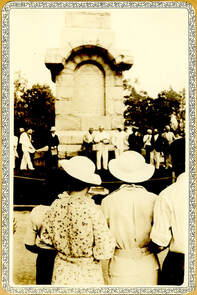 Gov. Curley Reviewing Parade Gov. Curley Reviewing Parade Acton’s 200th birthday was celebrated with a town-wide, three-day extravaganza. The event began at sunrise on July 20th with church bells ringing and a town crier announcing the occasion. The town was also greeted with an “unofficial” cannon salute orchestrated by Nelson Tenney. A Faulkner family reunion took place that day and brought numerous family members to the old homestead in South Acton as well as an impromptu reenactment of the activities there on April 19, 1775. The bicentennial celebration officially kicked off with a parade of military units and “motor floats” starting at 3 p. m., forming near the Faulkner House and heading to West Acton over Central Street. Participants were trucked from there to Acton Center where they were joined by civilian units west of Taylor Road on Main Street. They marched on Main Street through the center, passing the Monument where they were reviewed by dignitaries such as Massachusetts’ governor James M. Curley, ex-mayor of Boston John F. “Honey Fitz” Fitzgerald and other local notables. The parade ended at the Schoolhouse on Meetinghouse Hill. After the parade, there were speeches by the politicians and a rendition of “Sweet Adelaide” sung by John F. Fitzgerald. Florence Piper Tuttle, a poet and Acton native, read “Acton Speaks,” a poem composed for the occasion. After more speeches and a supper provided by one of the women’s clubs (reports varied as to which one), there was a band concert given by an American Legion Post Band from Watertown. On Sunday morning, the churches in town observed the occasion in various ways. The South Acton Universalist church had a memorial service for Lucius Hosmer, a former member who was born on the site of the church. He became a noted composer of his time and had written a piece for the celebration that he had planned to conduct. Unfortunately, he had died unexpectedly earlier in the year. On Sunday afternoon, there were open houses at fifteen of the oldest homes in town, followed by a concert on the Common entirely devoted to the work of Lucius Hosmer. His piece “The Acton Patriots,” composed for the occasion, was one of the pieces. The orchestra was part of the Emergency Relief Administration’s music program. In the evening, there was a community service that involved the pastors of the town’s churches and a 60-person community chorus under the direction of Harold Merriam. On Monday July 22, librarian and artist Arthur F. Davis led a 50-vehicle automobile tour over the approximate route taken by Capt. Isaac Davis and his Minutemen company to Concord on April 19, 1775 and then back past the Robbins farm site where a rider had spread the news to Acton that “The Regulars are coming.” Jenks Library has copies of the annotated tour itinerary. Next on the day’s agenda was a historical pageant that involved about 10% of the town’s population, held on the Acton Fairgrounds behind town hall. The E. R. A. orchestra apparently was involved as well. The celebration wrapped up with a Military Ball on Monday evening at Exchange Hall attended by invited guests (including Honey Fitz) and about 300 couples. The Liners Broadcasting Orchestra gave a concert there at 8, followed by a Grand March. Dancing then followed until 1 a.m. One has to be impressed with the effort that Acton residents put into celebrating their town’s bicentennial. According to newspapers, they were rewarded with the attendance of large crowds, 12,000 or more showing up on Saturday and 6,000 or more for the pageant. (It is not clear how accurate the estimates were. The Herald estimated 10,000 at the pageant.) There undoubtedly were many memorable moments for the participants, but judging from newspaper articles about the weekend, the most newsworthy event happened during the parade. The parade was in three divisions. First came the grand marshal Maj. Charles S. Coulter on his horse. He was followed in an open car by first division marshal George L. Towne, the last living member of the Capt. Isaac Davis Post of the G. A. R. Next came military units, including a band from Fort Devens, followed by a long line of army trucks that were used to transport marchers from West Acton to Acton Center to finish the parade. The second division was led by its marshal Lowell Cram and the Watertown American Legion band that drew particular attention because of its “girl drum major,” evidently a surprising sight at the time. Following them were about thirty decorated floats from Acton civic and other organizations such as the American Legion Auxiliary, Boy Scouts, Woman’s Clubs, Odd Fellows and Winona Rebekans, Grange, and the Concord Reformatory. The third division seems to have been made up of local, civilian and veteran marchers and horse-drawn vehicles. 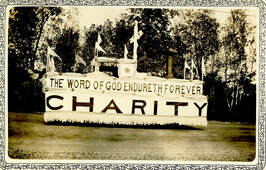 West Acton Baptist Church float West Acton Baptist Church float Governor Curley and the others reviewing the parade by the Monument had just seen the Center fire company go by. They were then able to see, five hundred yards away, a float farther back in the parade going up in flames. One can imagine the chaotic scene as the firemen took their chemical apparatus and raced back past the other marchers “with sirens screeching and bells clanging” to fight the fire. Reports mentioned that hundreds headed toward the excitement, necessitating a good deal of crowd control by local police and American Legion members helping out. The burning float represented the West Acton Baptist church. A sturdy framework had been built on top of and all around a truck owned by Jesse Briggs. The framework was then decorated with religious messages and flags. The float featured a pulpit displaying an antique Bible from the church. Driving the truck was the church’s organist, Alden Johnson, accompanied by the truck owner’s son Russell. When the engine caught fire in front of Horace Tuttle’s house on Main Street, Mr. Johnson pulled over. The doors being blocked, both men had to climb out of the truck’s windows and jump to safety. The firefighters were on the scene quickly, but they had a hard time getting to the engine fire, as the float was so well built that it took time to rip it apart. Somehow, the items on the float that belonged to the church made their way safely into the hands of its pastor, and no one was injured. The truck, however, had a very bad day. The importance of the bicentennial celebration to the townspeople who took part is evidenced by the large number of related items that were carefully saved and eventually donated to the Society. We have programs, articles describing the events, souvenirs, pins, photographs including three copies of a panoramic picture of the pageant’s participants, pageant dialogue written by Evelyn Knowlton, clothing worn in the pageant, a telegram sharing the news that one of the expected speakers was hospitalized, and letters from invited dignitaries who did not attend. Among the pictures, there is even one of the church float before its demise. Newspaper photographers were on hand to capture the firemen at work, their pictures accompanying articles with headlines such as “Two Jump from Blazing Float,” “Two Men Leap from Burning Float During Spectacular Parade in Acton,” and “Men Narrowly Escape Flames as Decorated Truck Bursts Forth in Fire at Height of Great Bi-Centennial Celebration with Governor as Guest.” The Boston Herald may have referred to “the little town of Acton, almost forgotten but sturdy and proud” (July 14, 1935, p.6), but those who attended the parade seem to have found Acton quite memorable. A Selection of Items in the Society's Collection: Sources Available Online:
“Acton Bells Will Ring on 200th Anniversary,” Boston Globe, July 13, 1935, p.20. “Acton Plans Three-Day Gala Celebration July 20, 21-22,” Concord Enterprise, July 3, 1935, p. 1. “Acton’s Bi-Centenary,” Boston Herald, July 14, 1935, p. 6 B. “Acton Celebrates 200th Anniversary”, Concord Enterprise, July 17, 1935, p. 1. “Acton Marks Bi-Centennial,” Boston Herald, July 20, 1935, p. 15. “Acton Cannon Booms at Sunup,” Boston Globe, July 20, 1935, p. 3. “Two Jump from Blazing Float in Acton as 200th Anniversary Fete Opens, “ Boston Herald, July 21, 1935, p. 1. “10,000 Attend Acton Exercises,” Boston Herald, July 22, 1935, p. 10. “Faulkner Family Annual Reunion,” Boston Globe, July 22, 1935, p. 19. “Military Ball Ends Acton Fete – 10,000 Witness Pageant Celebrating Town’s 200th Anniversary,” Boston Herald, July 23, 1935, p. 24. “Firing of Salute Opens 200th Anniversary in Acton” and “Military Ball Final Event of Observance,” Concord Enterprise, July 24, 1935, p. 1, 4. Additional Scrapbook Clippings with incomplete references: “Acton Celebrates 200 Years as a Town,” Boston Transcript, no date. “Historic Glories of Acton to Be Renewed,” Boston Post, no date. “Acton Holds Successful Bi-Centenary Celebration,” Concord Journal, no date. “Expressions of Regret” (from Franklin D. Roosevelt and Carlos B. Clark), no newspaper or date. "Blaze in Acton Parade Float Provides Thrills for Throng,"probably Boston Globe, no date. "Firemen Provide Real Exhibition of Quick Work," Boston Globe, no date. “Churches of Acton Note 200th Observance, Boston Globe, July 21, 1935. “Church Notes,” (South Acton), no newspaper or date. “Little Acton,” Boston Post editorial, July 16, 1935 (no page) “Pageant Brings Acton’s Celebration to Close,” labeled “Boston Globe, July 22, 1935,” but it was not in digitized version (or perhaps edition) of that day’s Globe. 5/2/2022 The Good Idea That Split a Town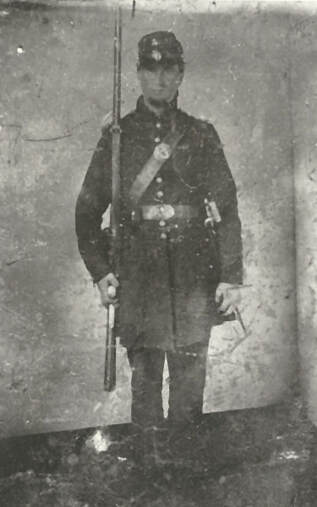 Soldier suggested to be Samuel Burroughs, Co. E, 26th Reg. Soldier suggested to be Samuel Burroughs, Co. E, 26th Reg. In our previous blog post about the postmaster controversy in 1880s South Acton, we mentioned that one of the underlying factors was probably resentment and distrust related to an ongoing dispute over the payment of bounties to some of Acton’s Civil War veterans. Despite repeated attempts by Acton’s townspeople to pay them, the veterans had never received the money. In 1882, Massachusetts enacted a law (Act of 1882, Chapter 93) that would have authorized the town to make the payment, but a lawsuit by a few influential (and high-income) taxpayers had sought to block it. The course of the controversy was somewhat complicated, but in the long run, to many Actonians, the issue became about more than money. Resentment festered and found outlets in a number of other disputes in the 1880s. The Background Acton sent several companies to the Civil War. The first, Company E, 6th Regiment, went out immediately upon Lincoln’s call for three-month volunteers in April 1861. After the men returned from their service around Baltimore, a company with a three-year enlistment was formed. Company E of the 26th Massachusetts Regiment was organized at Acton in August 1861 and was mustered into service in Lowell on Oct. 18. They were sent first to Ship Island in the Gulf of Mexico and then to Louisiana. Another company went out in August 1862 -May 1863, serving in Virginia, and a 100-day company served July-Oct. 1864 around Washington and on prison-guard duty on an island in Delaware Bay. Both of the latter companies were known as Company E, 6th Regiment. As in previous wars, it was important to the town that it supply soldiers to the cause. Towns were expected to fill a quota based upon population. If they could not fill their quota, they were threatened with a draft. Early in the war, patriotism and idealism were enough to get men to enlist. As the years wore on and the toll of war became more obvious, towns, states, and the federal government started offering financial incentives to induce men to join up. Known as bounties, the payments differed from place to place and over time. Not surprisingly, these disparities caused trouble. A federal bounty of $100 had been offered since early in the war, but it was deferred until the soldier was discharged (honorably). The Militia Act of 1862 required the states to institute a draft if they could not meet their enlistment quotas. In March 1863, Congress passed the Enrollment Act, authorizing a draft system, specifying that all able-bodied male citizens and immigrants who were applying to be citizens from 20 to 45 years of age would, if called, have to serve. Married men 35-45 would be drafted later than the others, and there were a number of exemption categories, mostly on the basis of the needs of family members. Most controversially, people could pay for a substitute to go or, if a substitute was not available, pay $300 to the Secretary of War for one to be found. The Enrollment Act and the ensuing Draft Riots in New York City that summer had pointed to the urgency of getting and keeping men in the ranks. On October 17, 1863, Lincoln issued a proclamation calling for 300,000 additional troops, to be raised by the states according to their quotas. Enlistments would be “deducted from the quotas established for the next draft” which, if a state did not make its quota, would begin on the 5th day of January, 1864. The Secretary of War upped the federal bounty, with a premium paid to reenlisting veterans. Meanwhile, Massachusetts was doing its best to fill its overall quota, and its towns were doing the same, offering bounties for enlistment or re-enlistment. Though originally the intention of the bounties was to support a town’s own soldiers, there was certainly an incentive to fill the town’s quota with any soldiers, wherever they could be found. There were some unintended consequences of the system, however. Unscrupulous recruits would sign up, claim a bounty, and never report to camp. These “bounty jumpers” might then sign up elsewhere, possibly under an assumed name, to get another bounty. Other frauds were to sign up and collect a bounty even though the recruit knew that he would eventually be rejected from serving (because of a disability or signing up underage, for example). A more basic problem with the system was that towns that could afford to pay large bounties were more likely to fill up their quotas than towns in greater financial difficulty. Disparities of bounties and the substitute exception yielded the impression that the rich were able to avoid the worst consequences of the war while the poor fought. Some of those who hired the substitutes, considering it a financial transaction, felt that they had the right to be reimbursed for their substitute payment. Some were of the opinion that those who went as substitutes, because they were paid to go in place of a drafted man, did not deserve the bounty for going to war. The divide between the poor, whom some judged for enlisting for the money offered, and the rich, who could afford to pay for a substitute, grew. There is no doubt that some bitterness that festered in Acton after the war was due to this economic divide. To try to introduce more equity into the system and to deal with some of the bounty-jumping problems, Massachusetts’ legislature passed a number of laws. In fairness to all parties in Acton’s bounty dispute, even with the benefit today of being able to read the digitized laws of the Commonwealth, the bounty laws make confusing reading. It must have been quite hard to keep up with them in the early 1860s, during a war, and especially in places with poor communication. Practice did not necessarily follow the intentions of the lawmakers. One of those intentions seems to have been that local bounties would stop, although towns seem to have interpreted the laws as limiting local bounties, not eliminating them (See Chapter 91, approved March 1863). A law passed in a special session in November 1863 (Chapter 254), set a uniform Massachusetts bounty at $325 for those who enlisted for three years. Though well-intentioned, the new law did not solve the problems. Rightly or wrongly, a number of towns’ representatives continued promising what they believed to be the maximum local bounty allowed at the time for the reenlistment of serving soldiers, $125. Acton’s Veterans Reenlist Acton’s bounty controversy centered on the soldiers of the 26th Regiment who had been sent to Louisiana in 1861 and served there through the beginning of 1864. During the company’s early service, the most harm came to the soldiers through disease. In June, 1863, the Regiment saw action at LaFourche Crossing and later made an attempt to take Sabine Pass. In the fall of 1863, it went to Opelousas and New Iberia, Louisiana. A November 27, 1863 letter from Delette Hall to his cousin Henry Hapgood (who had returned from the nine-month company sick) said: New Iberia is quite a villiage. About 50 miles from Breashear City on Bayou Teche River. This is quite a muddy place in wet weather We have to ditch the ground to keep from being drowned out Yesterday was Thanksgiving Day. but was not observed here except by issuing a ration of whiskey to the men. I thought of you all & if I was not there my mind was. I was on Picket & had a piece of salt pork & some hard tack for dinner. Well that was a little better than I had two years ago in Boston harbor. & next year I hope I shall be at home. We shall soon be nine months men our term expires the 18th Oct 186[4] which day we were mustered into the U. S. Service. It seems a long time to look ahead. I hope the rebs will get enough before the year is out. Clearly at that point, Delette Hall and his compatriots were not thinking of reenlisting. At the end of 1863, the Union army needed to keep seasoned men in its ranks. Experience showed that raw recruits were more likely to desert. The hope was that reenlisting soldiers would be inured to camp conditions, be willing to follow orders, and stay. Men who were acclimated to conditions in the South would have been considered an asset to the 26th Regiment. To understand what happened to spark the bounty dispute, we have to rely on testimony given much later. A two-sided supplement printed by the Acton Patriot laid out all that was said at a hearing before the Legislative Committee on Military Affairs, January 26, 1882 (in the Society’s collection and also transcribed by Brewster Conant). By the time one has read through the claims and counterclaims, one is hard-pressed to know what really happened. There were contradictions, inconsistencies over time, fading memories, and the influence of “circulars” and petitions on people’s interpretation of events (operating like the social media of the time). Also, by 1882, the needs of the war were long past, whereas the pinch of tax bills was a present problem. Though it is impossible to be completely sure of who knew what and when they knew it, most people in the post-war period seem to have agreed upon a few points. Acton’s Captain William H. Chapman, veteran of the 3-month original Acton Co. E, 6th Regiment and by late 1863 the Captain of Co. E, 26th Regiment, was also serving as the recruiting officer of the 26th Regiment. He was aware of the need for trained soldiers and of competition from other Massachusetts communities that he believed were offering local bounties to soldiers to re-enlist, with the quota credit going to those towns. Concerned that Acton would lose its soldiers to other towns offering financial incentives, Capt. Chapman told the men of the Acton company that Acton would “do as well by them as any other town” if they would reenlist to the credit of Acton. The going bounty rate at that point seems to have been $125. In later years, few disputed that the soldiers reenlisted in early 1864 in the 26th Regiment, for 3 years or the duration of the war, believing the promise that Acton would pay them a bounty of $125. Few disputed that Captain Chapman made the promise. The original dispute centered on whether or not he had been justified in making the promise and whether the town had the legal (or moral) obligation to keep it. Part of the problem with the later bounty dispute is that people were looking back many years and judging based upon subsequent events. At the time that Capt. Chapman was recruiting, the Regiment was in New Iberia, Louisiana. According to his later testimony, the mails were sporadic and it was not feasible to send messages to Acton by telegram. One can see how the captain might have felt that he needed to make decisions on the spot. Back home in Acton, however, there was a recruiting committee who felt that they should be the ones making decisions, particularly with respect to how the town’s money was spent. They also were more likely to have had a chance to read the laws passed by the legislature. The recruiting committee denied having authorized the bounties in advance and claims were made that no one knew about the bounty promise, but Luther Conant, longtime moderator, remembered that the issue was discussed at the 1864 town meeting. The war went on. After much of Company E reenlisted, the 26th Regiment was sent to Virginia where the company moved into action at Winchester (Opequon Creek) on Sept. 19, 1864, Fisher’s Hill on Sept. 22, and Cedar Creek on October 19. The company had lost a number of men to disease and also lost five men as a result of the fighting at Winchester, including Delette Hall's brother Eugene. Some were injured, including Captain Chapman, who managed to survive a gunshot wound to the head. The Company stayed around Winchester through May 1865. They spent a month in Washington, D. C., then were sent to Savannah. They were discharged in September 1865. Undoubtedly the men expected that when all was said and done, they would be paid their promised bounties. During the war, the town had paid some recruits bounties. The 38 members of the nine-month company recruited in the fall of 1862 received $100, with an additional $25 for the 23 recruits “called for from this town on the first quota” who signed up for three years. The town voted in December of that year that if it were required to supply more men, the recruiting committee was authorized to offer the same bounty to any who enlisted or were drafted. The 1862-1863 town report listed every man in service and whether or not he had received a bounty payment from the town. (The state seems to have retroactively reimbursed the $100 bounties paid to the 1862 recruits.) In November 1863, the town voted that the Selectmen plus three additional Recruiting Committee members would have discretionary powers regarding bounties. In November 1864, the town voted that their recruiting committee should investigate the claims of the town’s serving soldiers and those who had returned home and that the town should raise $5,500 to recruit men for the war. Given all of that, it does not sound unreasonable for Capt. Chapman to have thought that the town would back his claim that the town would do as well by its men as other towns were doing. However, the war ended, (most of) the veterans came home, and the claim had never been paid. The War’s Aftermath At the March 1866 town meeting, Acton debated paying those soldiers who enlisted in 1861 and reenlisted in 1864 the same bounty that had been paid to soldiers who enlisted later and served in the US service for less time. The town decided to postpone any action until the state and federal governments had taken action on bounties. According to Phalen’s history of Acton, “As things later developed this proved to be an unwise decision but at that time nobody could have foreseen that by this action the town planted the seeds for its most vicious and prolonged local battle.” (p. 197) Though this fact was not usually mentioned in the Acton fight, bounty claims took up a great deal of energy on the part of both state and national committees in the post-war years. The Massachusetts Legislature’s Committee on Military Affairs dealt with petitions of many towns, including petitions from Acton in three different sessions. Acton voted to pay soldiers’ back bounties in 1872 and petitioned to be able to pay it. In early 1881, the Committee heard petitions, not only from Acton, but also from Wilmington, Stoneham, East Bridgewater, Andover, and Natick, all rejected. Acton’s petition went nowhere until the third time it was presented in early 1882. In March 1882, the House passed a bill that would allow Acton to raise up to $4,000 to pay $125 to each of the veterans who had reenlisted in the 26th Regiment under the call of the president dated Oct. 17, 1863, were credited to Acton, and were never paid. The bounty could be paid to the soldier’s heirs if he had died. In response, at town meeting on April 3 1882, the town of Acton voted to pay the bounties, but the measure passed by only four votes (219 to 215). By this point, the controversy had split the town down the middle, apparently even at town meeting where Phalen wrote that “The glowering partisans congregated on either side of the center aisle.” (p. 231) Town meeting records mention that “it was voted to have the area in front and on each side of the Desk kept clear so that voters need not be obstructed in approaching the Polls.” Whether this was because of hostility or because it was Acton’s largest town meeting ever is not clear. After the vote, a cannon was shot off in South Acton in celebration (Acton Patriot, Apr. 6, 1882, p. 1) However, as often happened in Acton politics, a vote taken was not seen as final, but only as an opportunity to reconsider. Two town meetings followed. Both sides undoubtedly tried to sway opinions and get out the vote. The Acton Patriot’s Concord Junction reporter mentioned on Sept. 7, 1882 that “Thomas Clifford was earnestly sought for early Saturday morning by one of Acton’s heavy taxpayers. His object was to secure his vote against paying the soldiers’ bounty.” Probably the same heavy taxpayer “offered to bet $100 with any live men that the soldiers get beat.” (page 1) These efforts did not change the outcome, however. On August 21, an attempt to overturn the vote failed by 204 to 194, and on Sept. 2, the anti-bounty side lost again by 206 to 198. Phalen’s history of the town of Acton seems to indicate that the resolution of the bounty issue happened in 1882 with the Senate and House overriding the governor’s veto. “Thus ended the great bounty fight beside which all other Acton rows seem rather tame. The payments were made with reasonable promptness with one exception...” (p. 233). Searching Acton’s town reports did not yield a record of those payments; in fact, the bounty tax seems to have been assessed, held onto, and then without explanation refunded by the town. The reason was legal wrangling that went on much longer than is mentioned by Phalen. Not able to swing the vote in their favor, the opponents served an injunction on the town to prevent payment and hired Judge E. Rockwood Hoar as their counsel. According to newspapers of the time and legal synopses, the opposition’s case made its way through the legal system and was heard by the Supreme Judicial Court of Massachusetts in early 1885. The case hinged on the constitutionality of the 1882 act of the Legislature (chapter 93) that authorized the town to raise taxes to pay the bounties. According to the Supreme Judicial Court’s ruling, the town of Acton never promised to pay a bounty, did not (directly) receive the men’s services as soldiers, and was not responsible for paying them compensation. Therefore, it had no debt to them. Any payment made so long after the fact would be akin to a gift of gratitude to private individuals rather than payment of a debt for a public purpose (as inducing enlistments would have been). Taxes must serve a public, not private, purpose, and therefore, the 1882 law allowing Acton to raise taxes to pay the veterans of the 26th Regiment was unconstitutional. The bounty opponents must have thought that the matter would end there, but the dispute had gone too far by that time. By March, 1887, the town of Acton was petitioning the state to pay the bounties, because Acton was barred from raising the money itself. (Boston Journal, March 11, 1887, p. 1) Both sides testified again. The Society owns a copy of the opposition’s testimony that started with the statement that they were aware that they were “opposing the claim of the men, who, in a critical time in our history, rendered with such distinguished services to the country that it seems almost like robbery, - unpatriotic at least, to withhold from them anything in the way of pensions or gratuities that they may demand.” The opponents followed up, however, by saying that the Commonwealth owed the men nothing because this was a town matter. (Of course, the town previously had been kept from paying the claim by this group’s lawsuit.) The testimony ended with “We would respectfully ask, therefore, that you, as guardians of the public treasury against unfounded claims” would find against the town of Acton. The Society also owns a copy of the proponents’ testimony. The testimony mostly reiterated points made before, although it does contain a paragraph of personal attack on the opponents; the sides were portrayed as humble veterans versus the rich. At any rate, the Senate Committee on Claims reported favorably on the town’s petition. (Boston Journal, April 15, 1887, p. 3) In May, the Committee on the Judiciary ruled that the Legislature has the right to appropriate and pay money to individuals, even if it could be portrayed as a gratuity, if there were “some equitable ground upon which such payment ought to be paid.” (Boston Journal, May 5, 1887, p. 2) The legislative debate on the measure was reported in June, 1887. Some cited fear of opening the floodgates to other, similar claims. However, the majority, including Mr. Conant of Acton, felt that the resolve was an “act of justice.” (Boston Journal, June 8, 1887) Finally, the joint Resolve of 1887, Chapter 106 ordered that $125 was to be paid by the Commonwealth to the 31 soldiers (or their legal heirs) of the 26th Regiment who had reenlisted and never received the bounty they were expecting. The governor had objected to the Resolve, but the Senate and House of Representatives passed it over the Governor’s objections on June 16, 1887. The fight was finally over. The veterans got their bounties and apparently it was the people of Massachusetts as a whole who made good on the promise, rather than the people of Acton who had voted repeatedly to pay it. It is clear that a dispute allowed to fester for over 20 years was extremely harmful for the town. Putting off dealing with the problem in the hope that it would conveniently disappear led to infinitely more trouble later. As the bounty dispute dragged on, campaigns for support, including assumptions, exaggerations, and character slurs, led to increasing polarization. Both sides’ attitudes seem to have hardened into a belief that they were fighting for the “right.” Newspapers elsewhere noted Acton’s contentiousness with comments such as “Acton folks are still squabbling...” (Springfield Republican, Aug. 19, 1882, p. 6) What becomes most apparent is that the bounty dispute reflected divisions in society. On the one hand were those trying to prevent payment. They portrayed the veterans asking for bounties as greedy opportunists who had not received a legitimate (or perhaps any) promise of payment before they reenlisted and who were trying to take hard-earned tax money from Acton’s struggling farmers and from families of veterans who had not received a bounty. Those supporting the bounties believed that the town should make good on the promise. They portrayed the men against the bounties not as struggling farmers, but as rich taxpayers who were too stingy to pay the money that had been promised to men who risked their lives in the war. Underneath the accusations were basic issues, especially about who has the right to run the town. Should it be the influential, well-to-do men who had served (and controlled) the town for many years, or less-wealthy men who perhaps moved about looking for opportunity? The committee at home during the war had been either elected or appointed and felt they had the right and the duty to act for the town and decide how to spend its money. Those who were far away in the field at the time felt justified in recruiting for the town. The fact that there was some justification for both sides’ viewpoints made the divisions much more entrenched. As is often the case, after all of the conflict that was reported in the newspapers of the day, the actual resolution and payment of the bounties was apparently done without much fanfare. Though it is likely that the participants remembered the vitriol involved in the dispute, life moved on. Three years later, Acton had a Memorial Library honoring its veterans’ service. Acton’s veterans of the 26th Regiment (and of the bounty fight) were proudly listed at the entrance of the new Library. References:
In the nineteenth century, people from larger places seem to have regarded Acton as a “quiet farming town,” or even “semi-lethargic.” (Boston Globe, July 21, 1885, p. 2 and Sept. 16, 1885, p. 8) It therefore came as a newsworthy surprise that 1880s Acton kept erupting into conflict and then apparently retreating into festering resentment. Our foray into 1880s Acton started with an article entitled “OUSTING AT ACTON” that reported that two Republican postmasters had been replaced by two Democrats. (Globe, Sept. 5, 1885, p. 5). That might have been an interesting story, except that South Acton’s incumbent postmaster J. K. W. Wetherbee was in fact a Democrat, as was his replacement. Trying again, the Globe added to the excitement on Sept. 11 with an article entitled “SCHEMING POSTMASTERS – Charged with Fraud by the Government.” (p. 2.) This was a story of both politics and potential fraud; to understand what was going on, we had to learn about the role of a small village (fourth class) postmaster in the nineteenth century. Acton’s Early Postal Service Today, we are accustomed to having mail delivered to us. People living in Acton before the twentieth century did not have that luxury and had to pick up their own mail. Sometimes people had no idea that letters were waiting in a post office; a postmaster would advertise a list of letter recipients in the local paper. Digitized newspapers show that practice existed even after 1900. (Concord Enterprise, Feb. 26, 1902, p. 8). Before Acton had a post office of its own, the Concord postmaster periodically advertised that Acton residents had letters awaiting them there. (See Middlesex Gazette, Oct. 11, 1817, p. 4, for example.) According to Shattuck’s 1835 History of the Town of Concord, at some early date, a post office was briefly established in Acton in the care of “Mr. Perham” and then reestablished in 1828 in the Acton Center law office of Silas Jones. Acton has had its own postal service since that time. In the very early years, mail was not common, and people picking up letters were expected to pay the delivery cost. The advent of pre-paid postage stamps made picking up letters less expensive to the recipient, but it still entailed a trip; obviously, it was advantageous to have a post office closer to one’s home or place of business. A village needed a certain size to attain its own post office. The 1844 arrival of the Fitchburg Railroad led to growth in both West and South Acton. In 1848, West Acton’s first post office was established in the office of Dr. Reuben Green. In December 1851, South Acton got its first post office with postmaster Ezra C. Radiman (name spelled variously, exact location as yet unknown). East Acton, known then by the name of Ellsworth, got its own post office in March, 1873. The postmaster, l. W. Flagg, had a store there. North Acton did not have a post office until March, 1886 when Charles Miller was appointed postmaster. The postmaster would have been responsible for people’s mail and also for money. One would hope that people were appointed on the basis of their competence, honesty, and incorruptibility, and that may well have been the case in Acton. In general, being able to appoint the postmaster was considered a privilege of elected officials who apparently often used that power to distribute patronage jobs. Postmasters were expected not to use their position to promote their political party’s candidates, but the postmaster’s role at the center of village life was certainly a useful connection for politicians. Until late in the nineteenth century, the location of the post office would depend upon the postmaster. As the 1800s progressed, Acton’s village post offices were often located in a postmaster’s store. Having people’s mail would have increased foot traffic to one’s business. The postmaster’s tenure was not guaranteed; after an election, the position might go to a competitor from the winning party. Though changes in postmasters are traceable through records, the actual politics behind some of the appointments are not always clear. For example, in 1855, newspapers including the Boston Atlas (July 19, 1855 p. 2) alleged that the Acton “Centre” post office was being kept in the barroom of the Know Nothing House (a reference to a political party of xenophobic tendencies), but the July 25 Boston Herald clarified that the hotel, apparently run in the past by a Know Nothing supporter, was now run by a Democrat. The post office had been moved from the shoe shop of John Fletcher to the “public room” of a small county hotel that served no liquor. (p. 2) Phalen’s History of the Town of Acton describes old-timers’ memories of the Center post office in the hotel. It had a “unique contrivance for mail delivery” that operated like a Lazy Susan. “There were pigeonholes marked with the letters of the alphabet. A person seeking mail would turn the wheel until his initial appeared at the opening whereupon he separated his mail from the rest and departed, unless of course the office happened to be vacant and he were of a curious turn of mind. In later years the device was abandoned and standard boxes installed with a pull bell that would summon the postmaster.” (p. 192) Changing the post office location would obviously necessitate moving or installing people’s mail boxes. 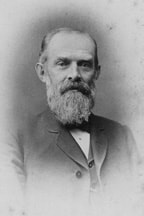 JKW Wetherbee JKW Wetherbee As mentioned, the postmaster job was considered a patronage position, often jealously guarded by the Representative in power at any given time. Surprisingly, in Acton, a more evenhanded approach had been taken under the Republican administration leading up to the 1885 brouhaha. The practice had been to select two Republicans and two Democrats for the four village post offices in town. (Globe, Sept. 16, 1885, p. 8) Part of this magnanimity may have been due to the confidence of Acton Republicans that the town was “sure to go Republican.” (Boston Journal, Aug. 18, 1884, p. 2) The pay of the postmasters was dependent on the volume of business. According to the Globe (Sept. 11, 1885, p. 2), postmasters of the smallest, “fourth class” post offices did not receive a salary per se but earned percentages of the stamps cancelled at the office each quarter: 100% of the first $50 with declining percentages (60, 50, 40) on amounts above that. There was an incentive to increase the amount of mail sent through one’s office, but there would be a natural ceiling on the number of letters leaving a small village. Another source of business would be companies’ “circulars,” essentially advertising flyers that would be sent out in bulk. The Globe claimed that certain postmasters had concocted “an ingenious little scheme” for the mailing of large quantities of circulars at their offices that, arguably, should have been deposited at the large offices. Someone in Washington decided that small post offices sending out circulars was a sign of irregularities and sent the postmasters a bill for past commissions earned on the circulars. The ingenious, accused plotters were the postmasters of Littleton Depot, Littleton Common, South Acton, Townsend, West Townsend, and a few other places. Caught in this situation was Jonathan K. W. Wetherbee, a pillar of the South Acton community, partner in the highly successful firm of Tuttles, Jones & Wetherbee, long-time town treasurer, selectman, and, on occasion, lender of money to the town. He had served as South Acton postmaster since the fall of 1870. When J. K. W. Wetherbee was replaced by another Democrat amidst accusations of fraud, the degree of excitement in Acton was, according to the Globe, more than one might expect from the occurrence of a cyclone or a raging epidemic. (Sept. 16, 1885, p. 8) Fraud or Politics? The author of the Sept. 16 Globe article actually talked to J. K. W. Wetherbee to get the postmaster’s story. Apparently, C. M. Lawrence, Littleton resident and representative of a Boston business, had approached outlying postmasters saying that he wanted to send circulars from their offices. The Forge Village postmaster had checked with his Washington boss whether he could refuse to accept them, as the sorting was going to add to his work load. The official response was that the postmaster was required to accept all mail presented to him and that most postmasters would welcome the extra business. When J. K. W. Wetherbee was offered the same business opportunity, he contacted Washington and was told to send a copy of the circular. He did and received no reply. Having fulfilled his obligation, and in light of the response to the Forge Village query, Wetherbee felt confident that the circular business was acceptable. Several years later, however, he received a bill from the government for over $1,000 in past commissions. In his interview with the Globe Reporter, J. K. W. Wetherbee stated: “My office cost me $100 the first year I had it on account of help I had to hire, as my business would not allow of my giving it much of my personal attention, and the office has been broken into and robbed three times. Thus I think I have been robbed enough already. It seems rather singular to me that after communicating with the department relative to this circular business, and having my quarterly accounts audited and allowed, that this demand should now be made upon me.” After this point, the story seems to have disappeared from the newspaper. In typical fashion, the exoneration of the postmasters seems not to have been reported. J. K. W. Wetherbee served as the town’s treasurer and in other positions of trust into the 1900s and continued to lend the town money; clearly the townspeople did not question Mr. Wetherbee’s character. No one seems to have given credence to the charge of fraud. Nonetheless, Wetherbee was replaced as postmaster. There must have been more to the story. According to the Sept. 16, 1885 Globe, Ruel Williams, a member of the town Democratic Committee selected to go to the state convention, went to see James Tuttle, another Democratic pillar of the South Acton community who was a business partner and brother-in-law of J. K. W. Wetherbee. Tuttle was told that Wetherbee probably would have to go. The implication seemed to be that it was due to the fraud charge. The national Democratic party had just elected its first president since 1856 with a platform that included civil service reform. Perhaps the local committee was trying to impress the State Committee by “cleaning house.” James Tuttle was upset that other Democrats in town had not been informed of the potential change, and no one had talked to J. K. W. Wetherbee. Tuttle had planned to start a petition, but the postmaster change was made before he even had a chance. He said, “We are all mad, all classes, sects and political complexions. Yes, indeed, the village of South Acton is stirred up.” Accusations and counter-accusations from supporters followed, but the change was made. 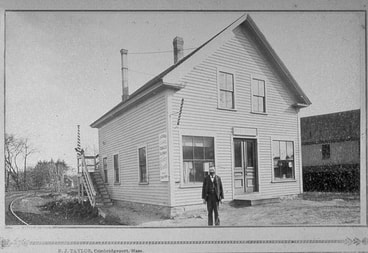 South Acton Post Office, south of railroad crossing South Acton Post Office, south of railroad crossing Though the committee prevailed, they had omitted to consider one detail in their planning. Tuttles, Jones & Wetherbee owned much of center of South Acton. The post office had been located in a James Tuttle-owned building, apparently in the news stand of Dana Hayward who worked as postal clerk. The replacement postmaster Lorenzo Reed found that no location was available in the village for him to establish his post office. As James Tuttle said, “I don’t propose to turn out good tenants to please him.” Eventually, the new postmaster, “accompanied by a justice of the peace, visited every property owner in the centre of the village who had land or a building which could be utilized and offered to buy, hire, or lease such, but no opportunity to do so was offered him.” His only recourse was to move the post boxes to his own residence. (Globe Oct. 20, 1885, p. 2) People were quite unhappy that they were going to have to trek to his house to get their mail, but eventually the furor died down as people realized that Reed was in a difficult position. Later, the post office was moved to a small building on the south side of the railroad tracks. Small town, Big Disagreements So why did this conflict erupt in the first place? We have not found anything to indicate that J. K. W. Wetherbee deserved to be replaced as postmaster, or even any reason that anger would specifically have been aimed toward him. What we did find was that Acton residents in the 1880s were quite disputatious. For example, as described in a previous blog post, in the spring of 1884, a disputed school committee vote for Superintendent led to two men claiming to be have been appointed, with angry supporters on both sides. Within three years, a bitter conflict over a teacher led to the resignation of a different Superintendent and most of the school committee. Rancor and factionalism seem to have been habitual in Acton at the time. The biggest conflict, and perhaps the root of much of the distrust and anger in town, was a dispute over paying back bounties to Civil War soldiers that consumed a great deal of energy in the early 1880s. Like the postmaster “muddle,” the bounty fight requires some background to understand and is the subject of another blog post. What Goes Around Comes Around Lorenzo Reed only served as postmaster until 1889. Democrat Grover Cleveland lost the 1888 election, politics shifted, and many postmasters were replaced in the following year. Time moved on, but complaints from South Acton didn’t completely die down. A petition campaign was initiated to influence the choice of postmaster in 1889, though that did not go far. (Concord Enterprise, Apr. 5, 1889, p. 2) On July 12, 1894, an item appeared in the Enterprise that fireworks were being sold in the post office, with pointed advice to the postmaster to “read what Uncle Sam says about it.” (p. 8) In 1897, there was a petition to appoint Frank W. Hoit as postmaster and to locate the office on the north side of the Fitchburg railroad. Rumors were flying that the signers of the petition were only schoolchildren; in fact, the petition was signed by the businessmen of the community, including many Tuttles, Jones, and J.K.W. Wetherbee. (January 14, 1897 p. 8) One of the signers was James Tuttle’s son H. Waldo, who was at the time serving as postmaster himself. On July 1, 1897, the Concord Enterprise reported that “The old post office is being fitted up for the new postmaster, who is expected to take possession July 1.” (p. 8) After all the controversy, the post office was back in James Tuttle’s building. |
Acton Historical Society
Discoveries, stories, and a few mysteries from our society's archives. CategoriesAll Acton Town History Arts Business & Industry Family History Items In Collection Military & Veteran Photographs Recreation & Clubs Schools |
Quick Links
|
Open Hours
Jenks Library:
Please contact us for an appointment or to ask your research questions. Hosmer House Museum: Open for special events. |
Contact
|
Copyright © 2024 Acton Historical Society, All Rights Reserved
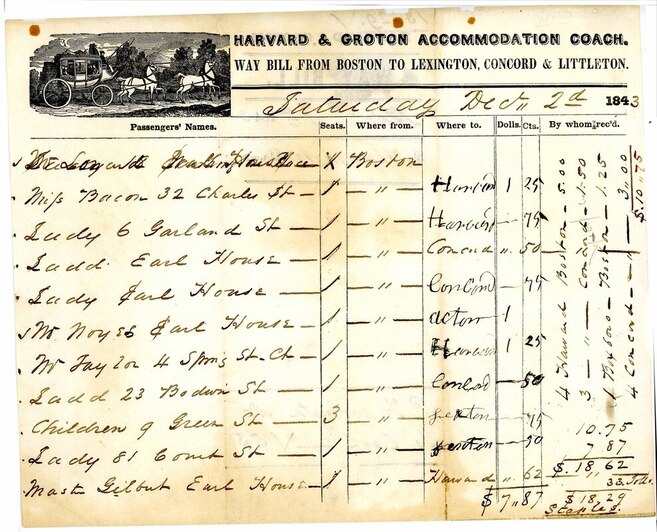
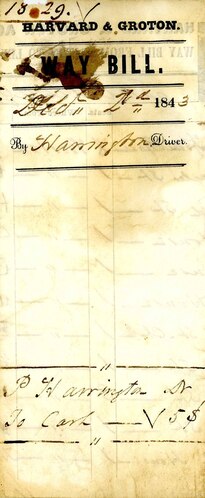
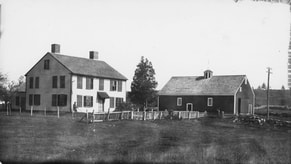
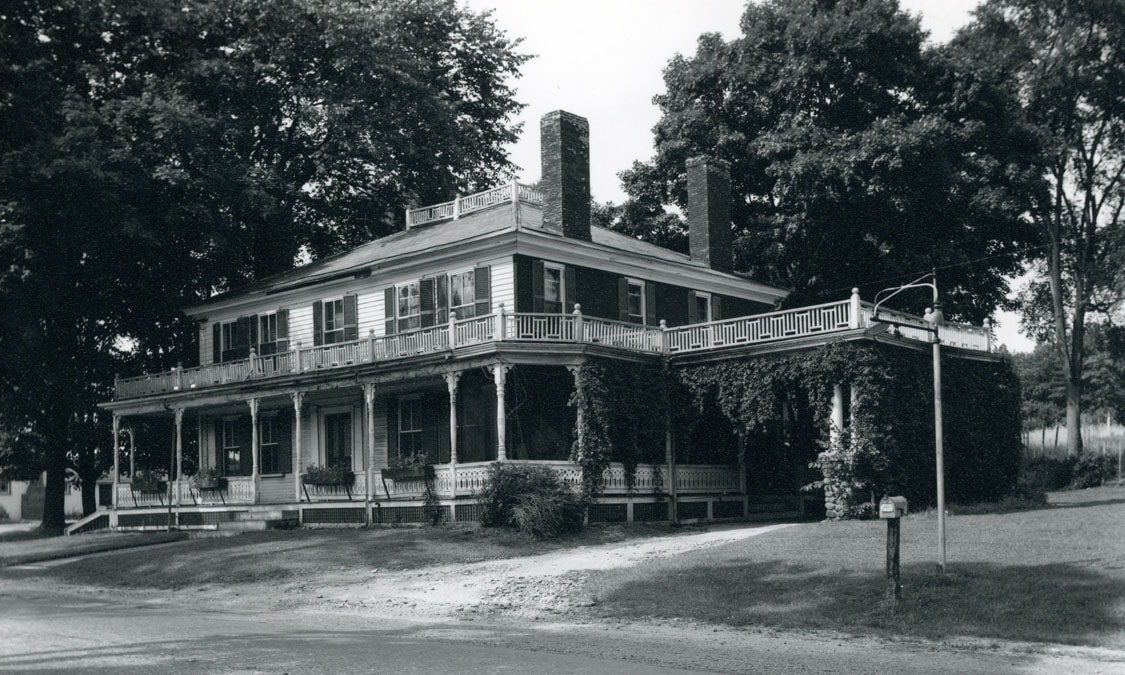
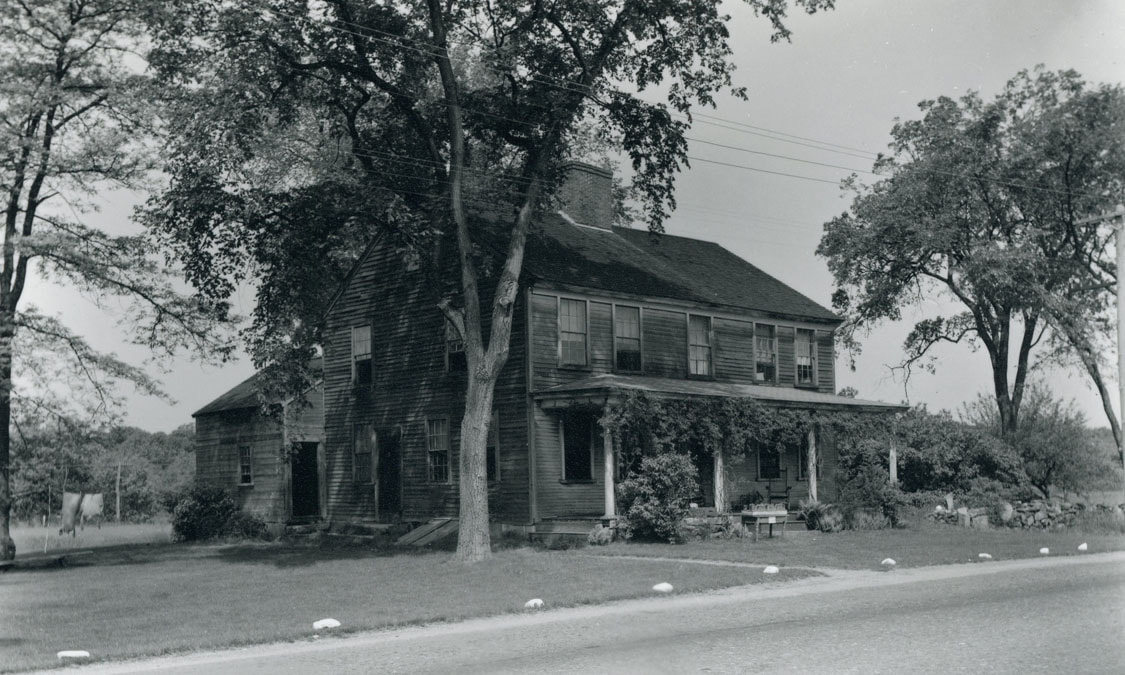
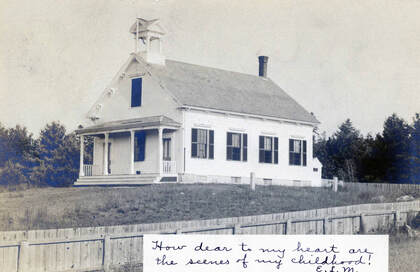
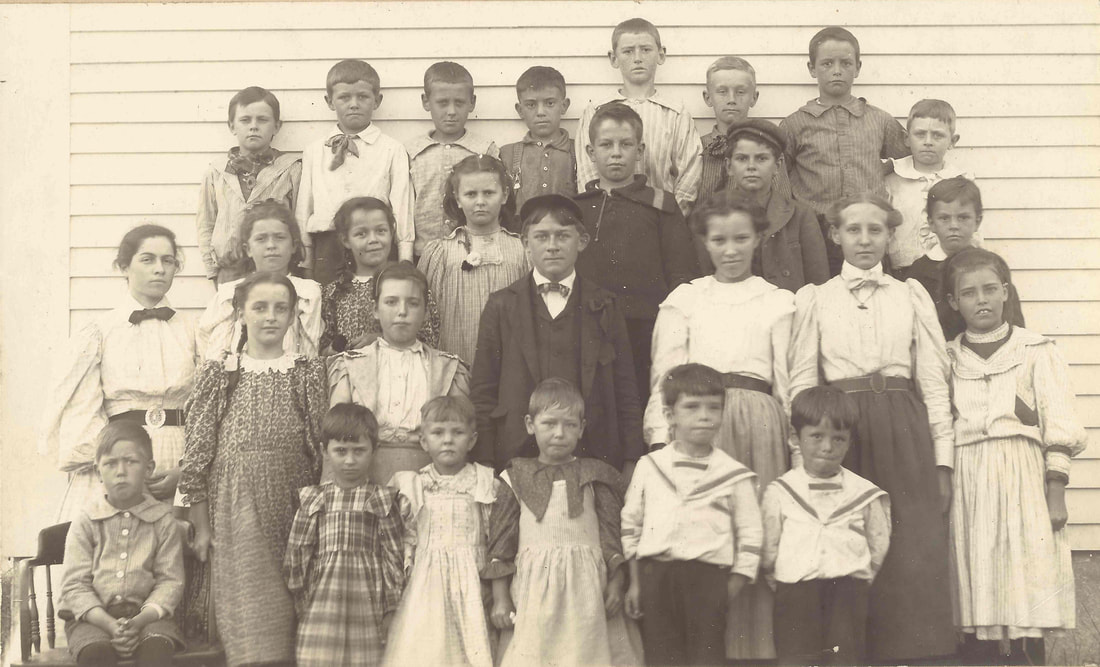
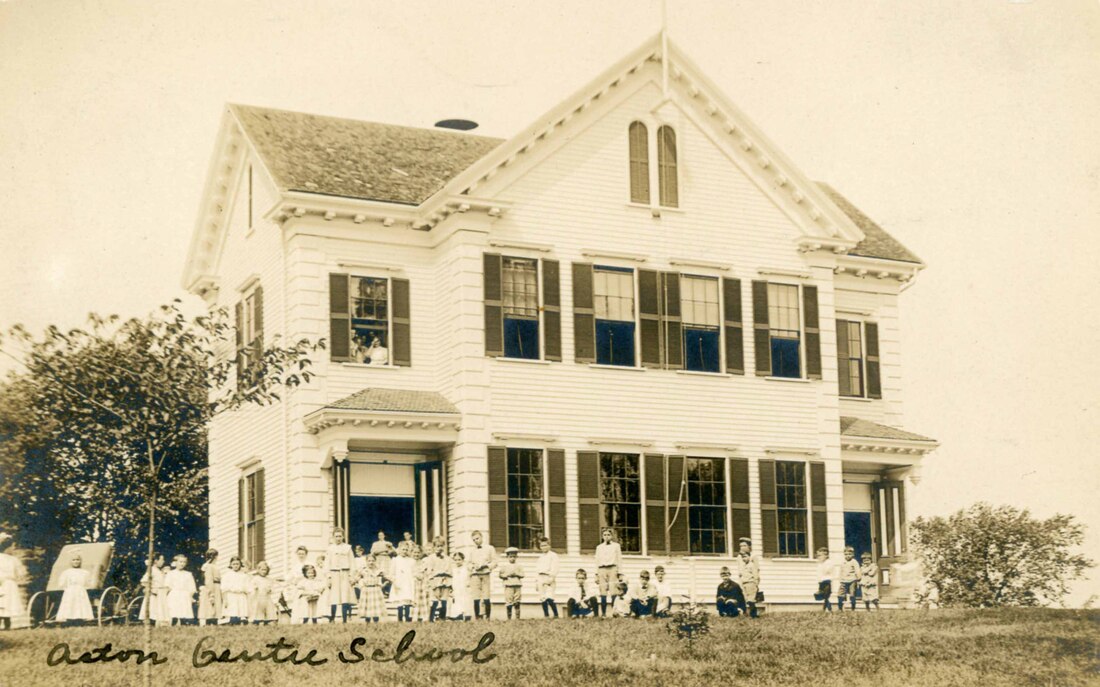
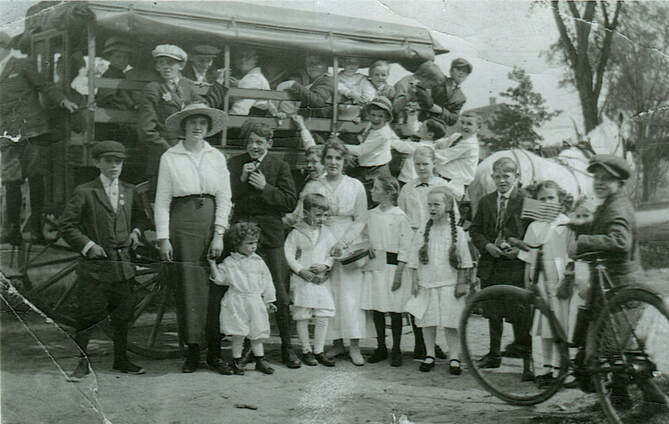
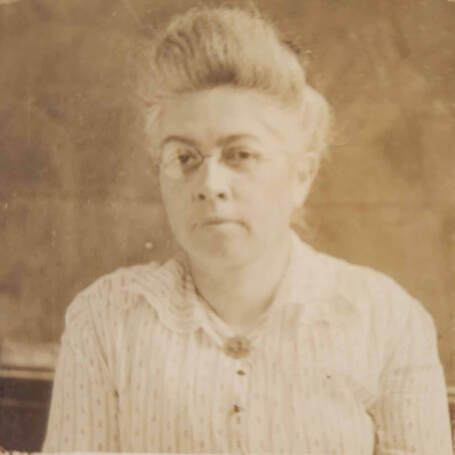
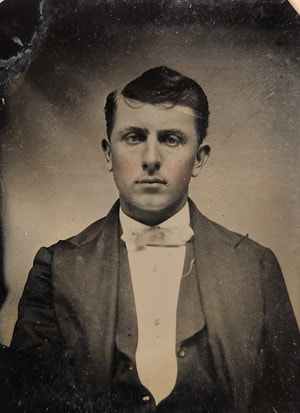
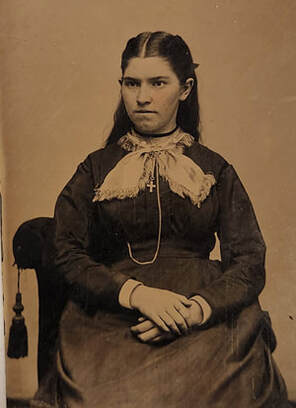
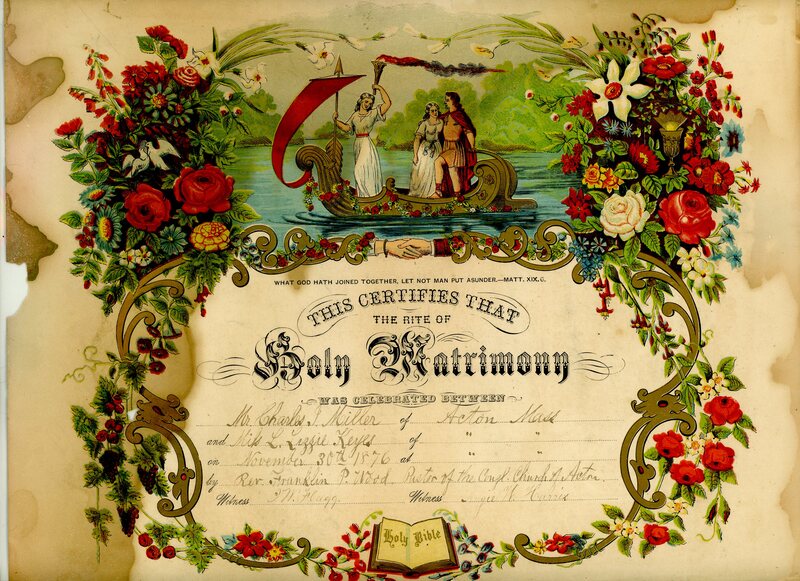
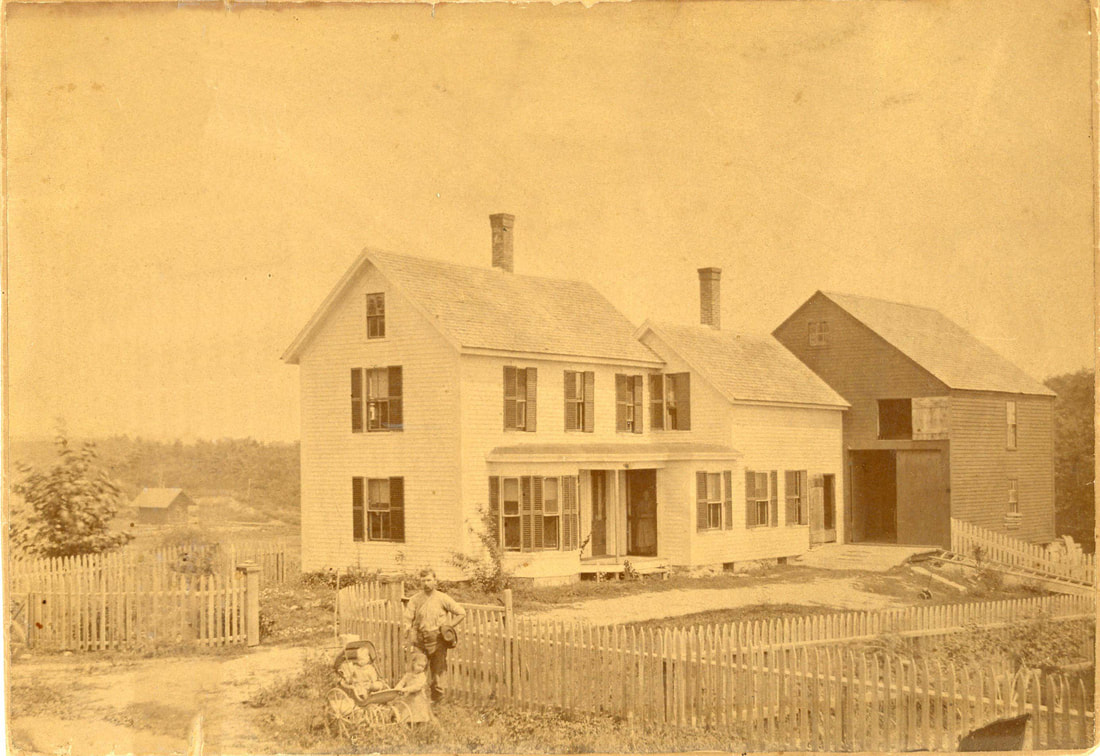
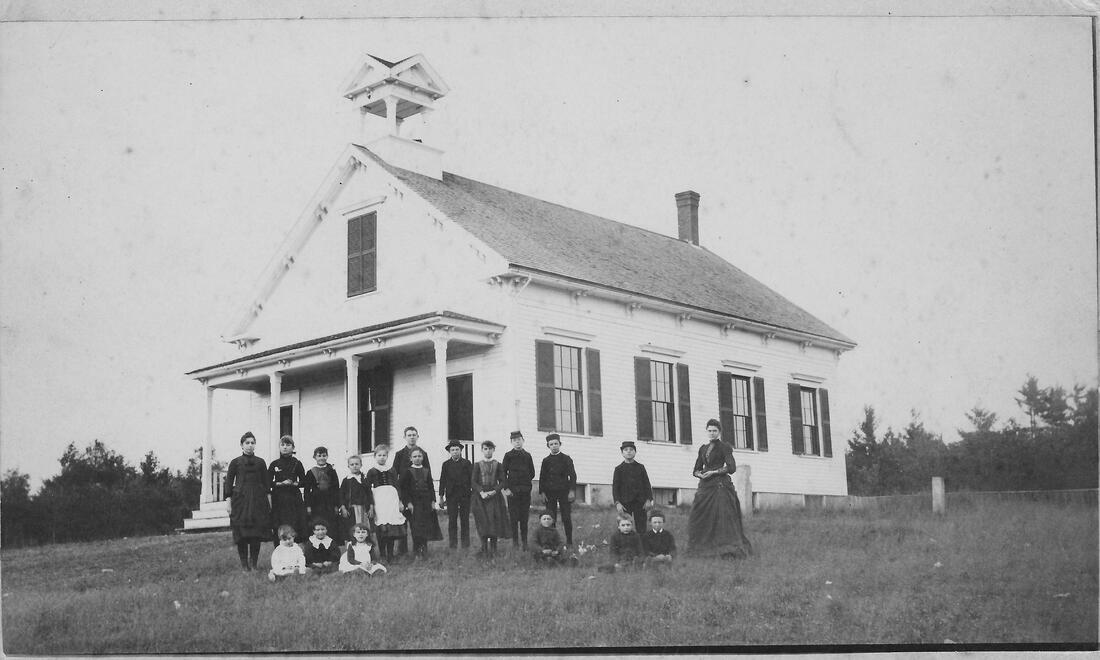
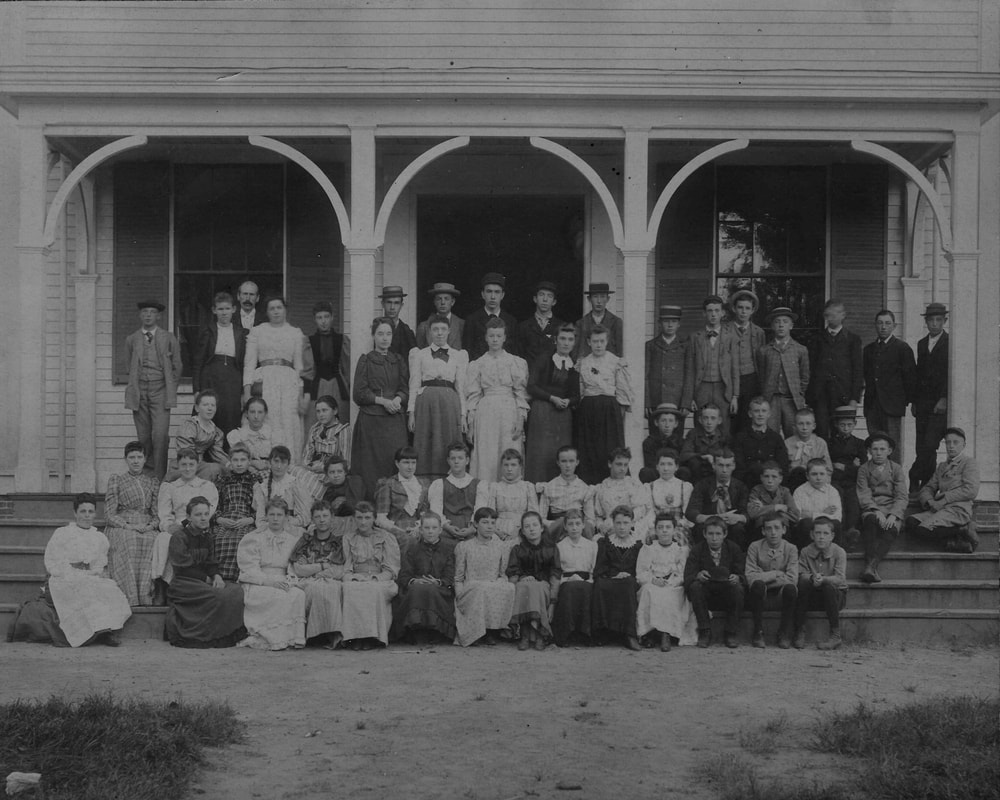
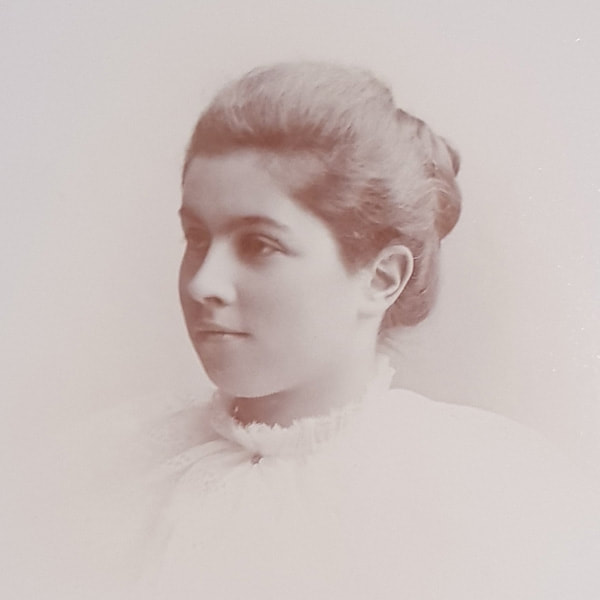
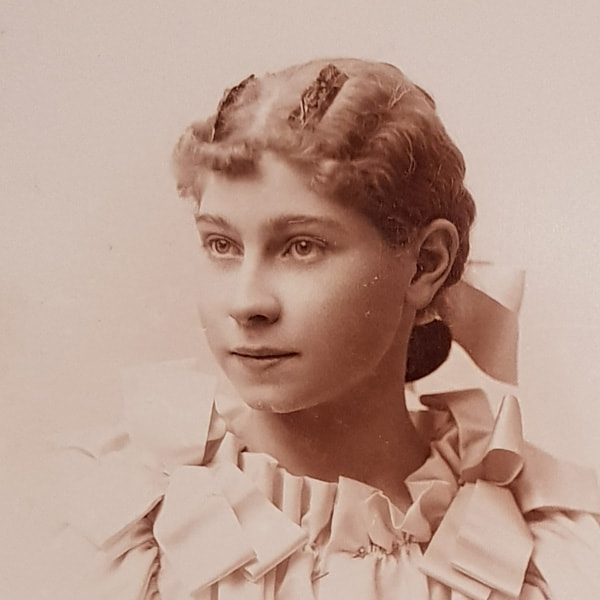
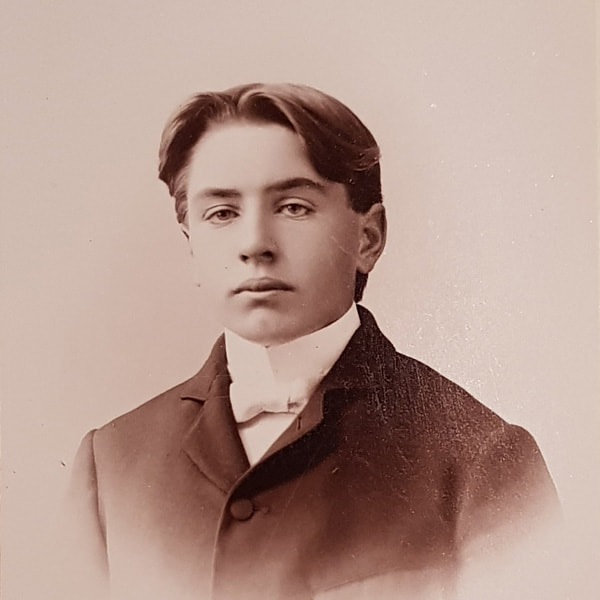
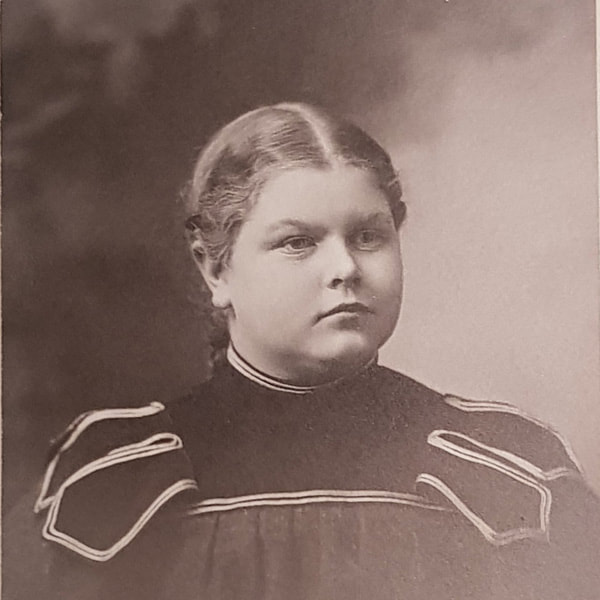
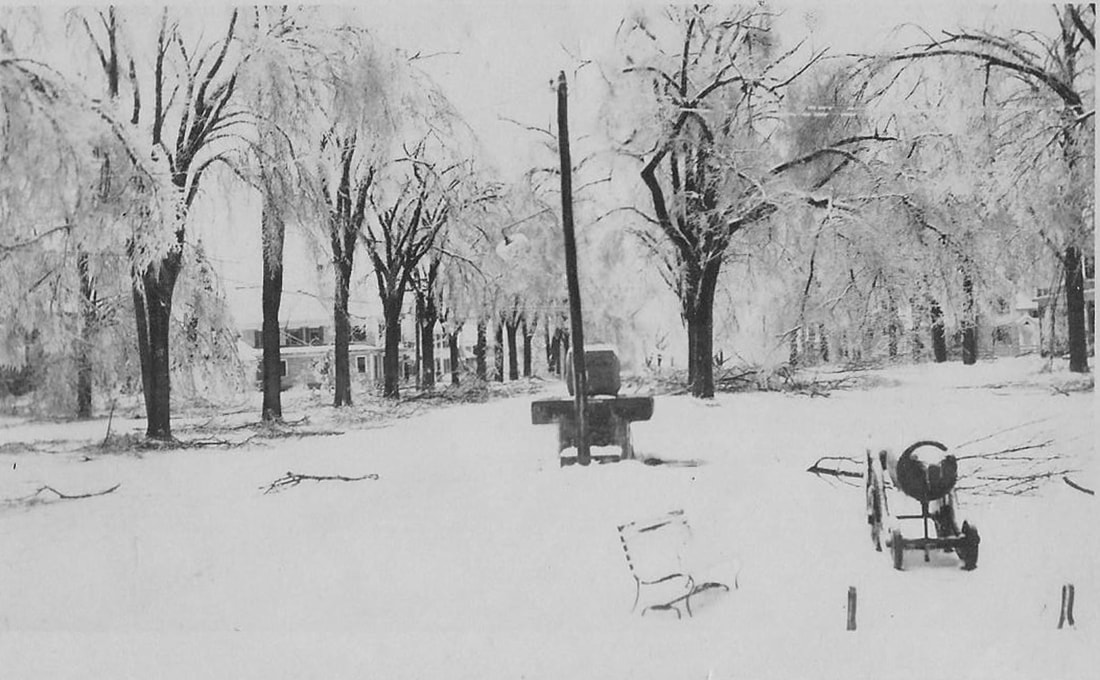
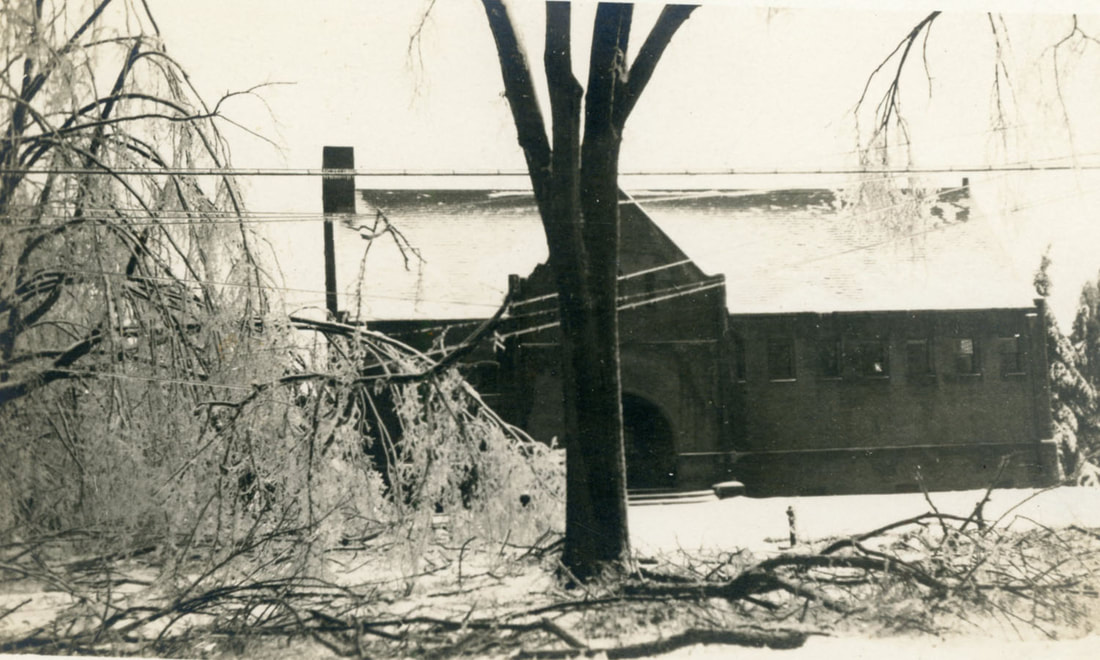

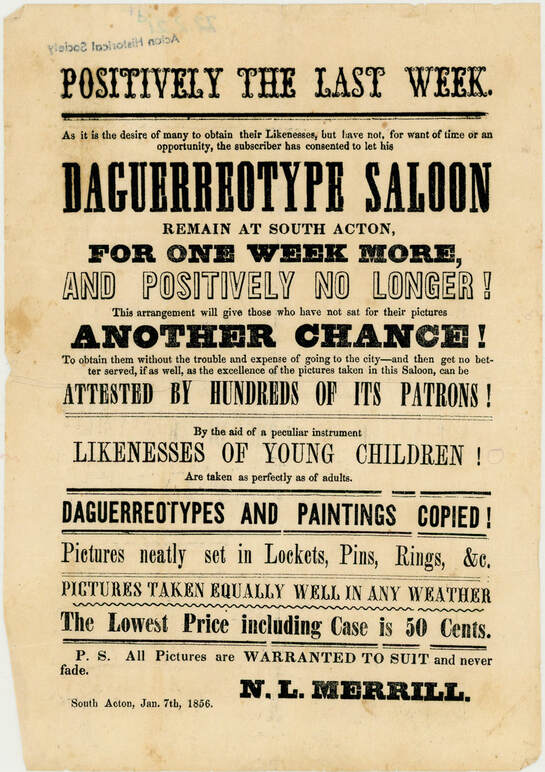
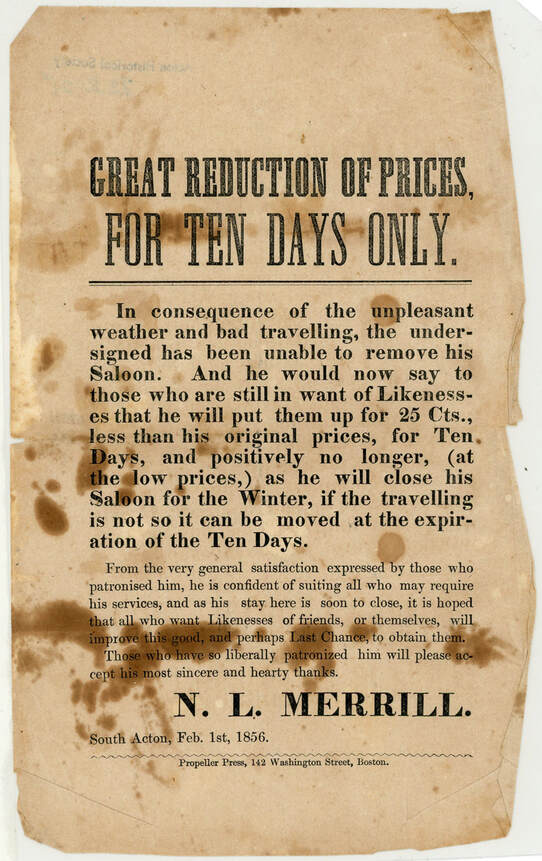
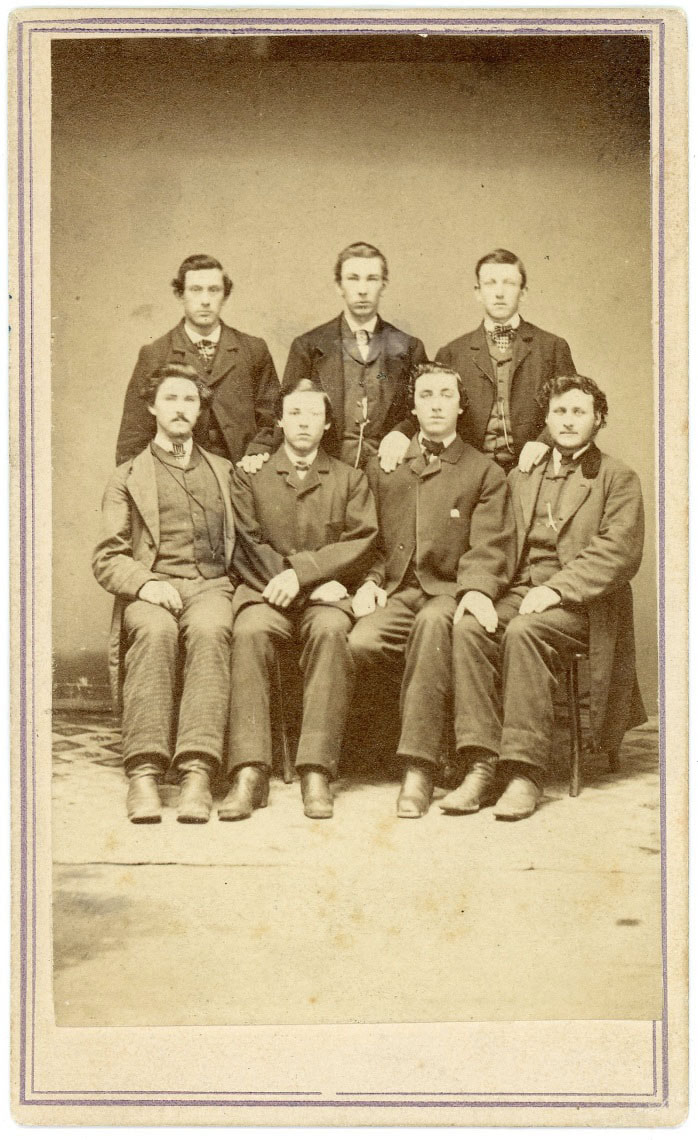
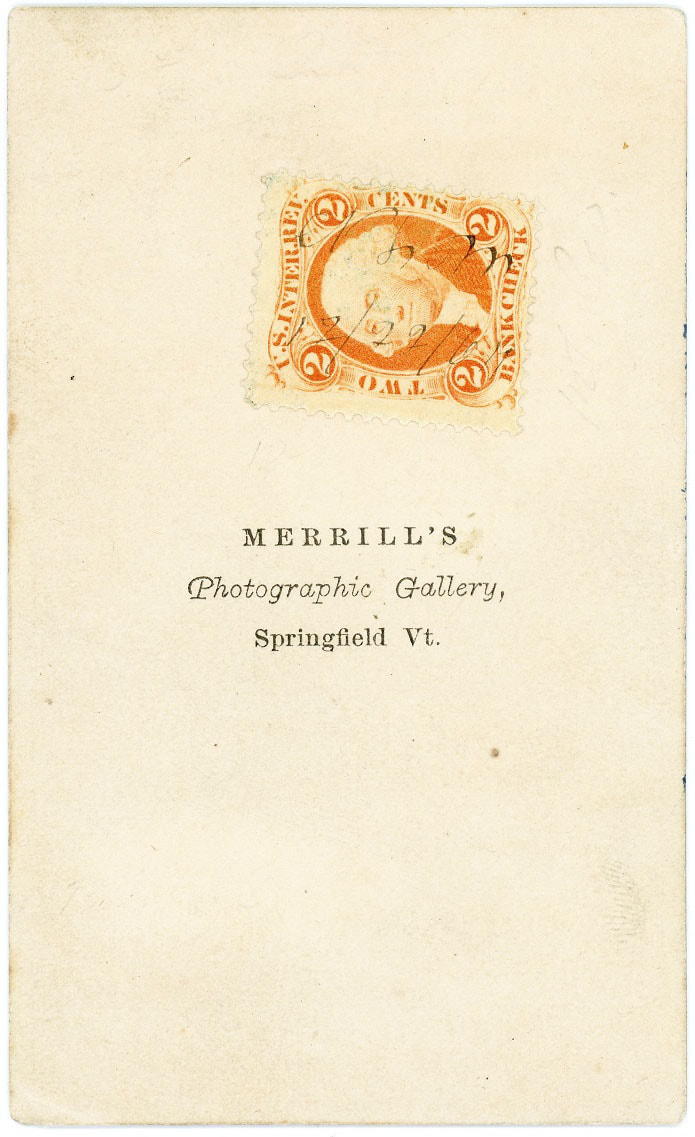
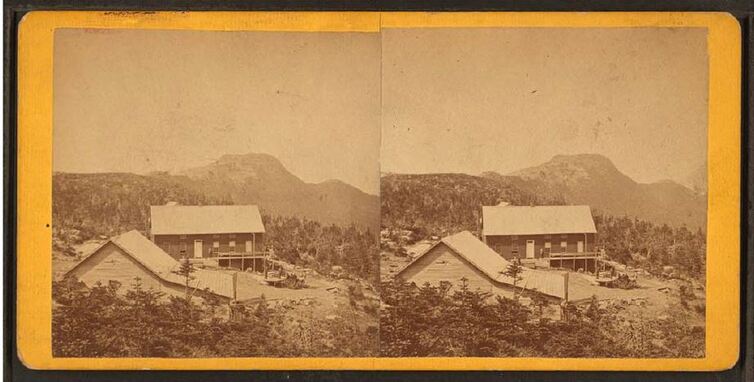
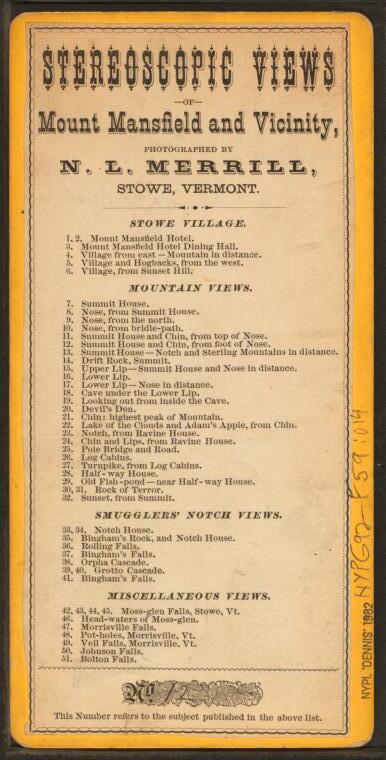
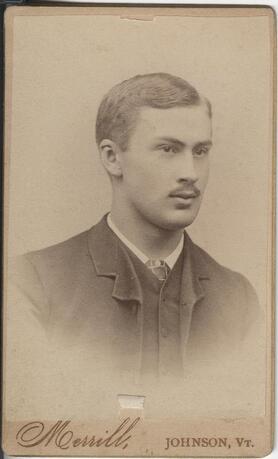
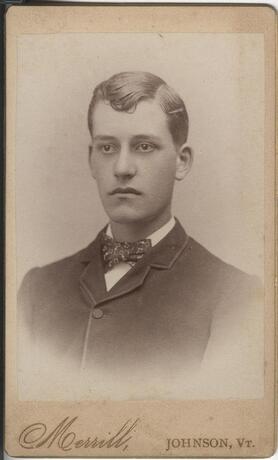
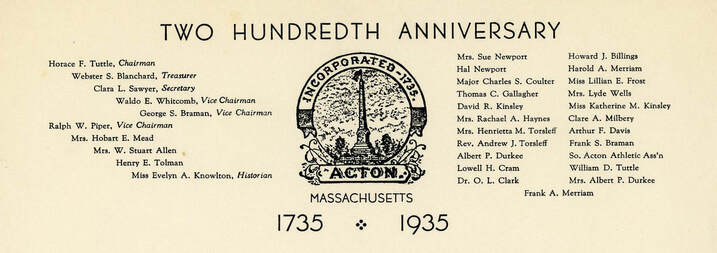
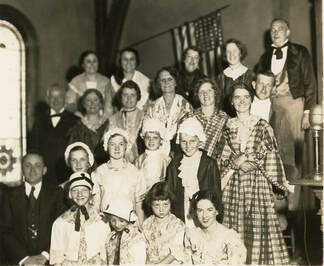
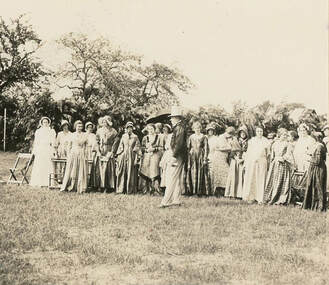
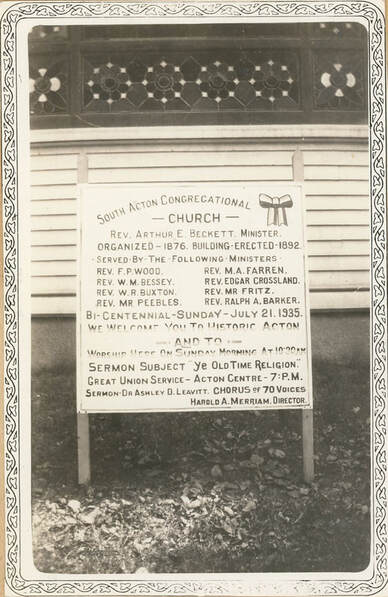
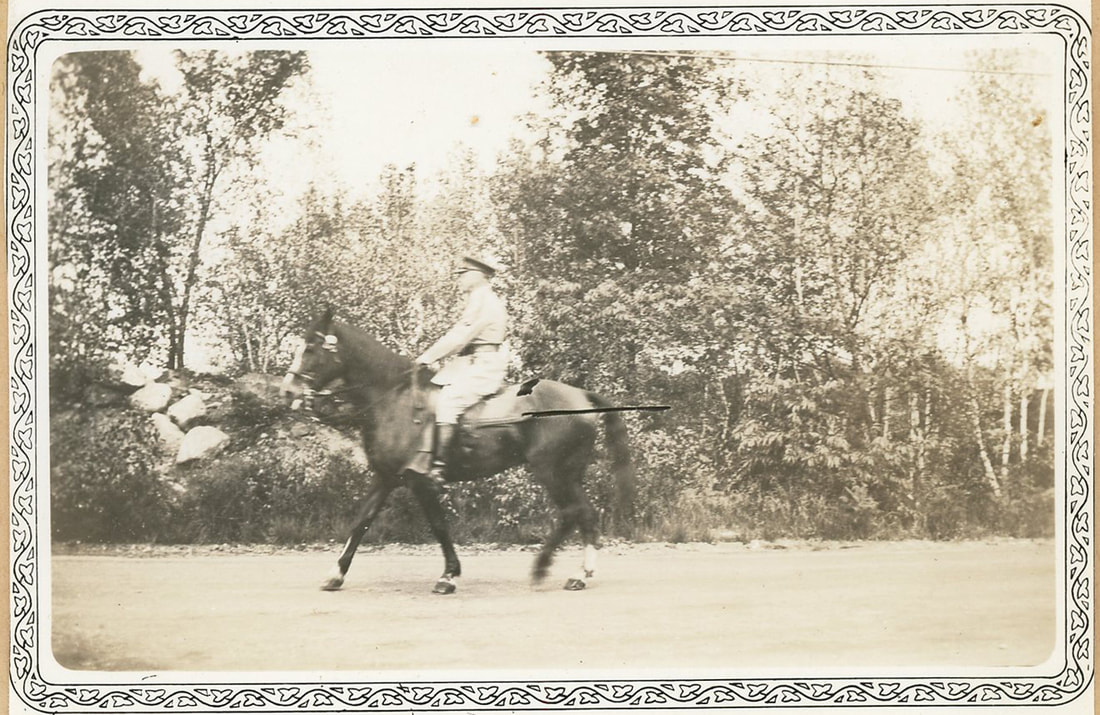
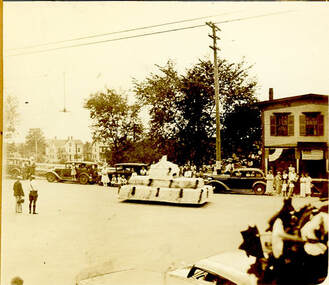
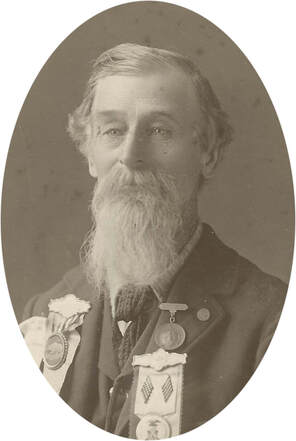
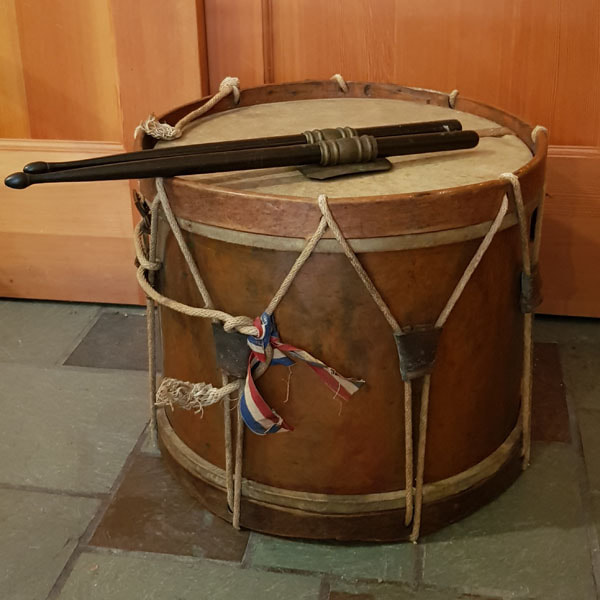
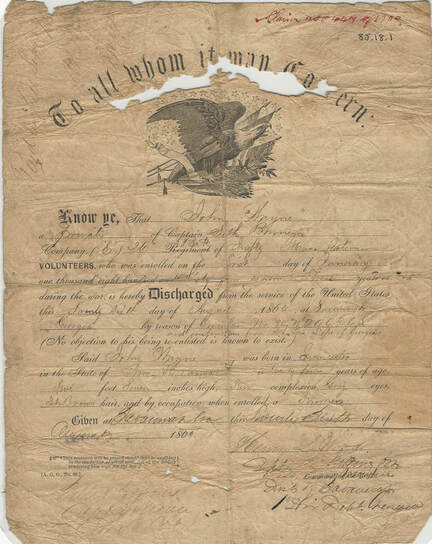
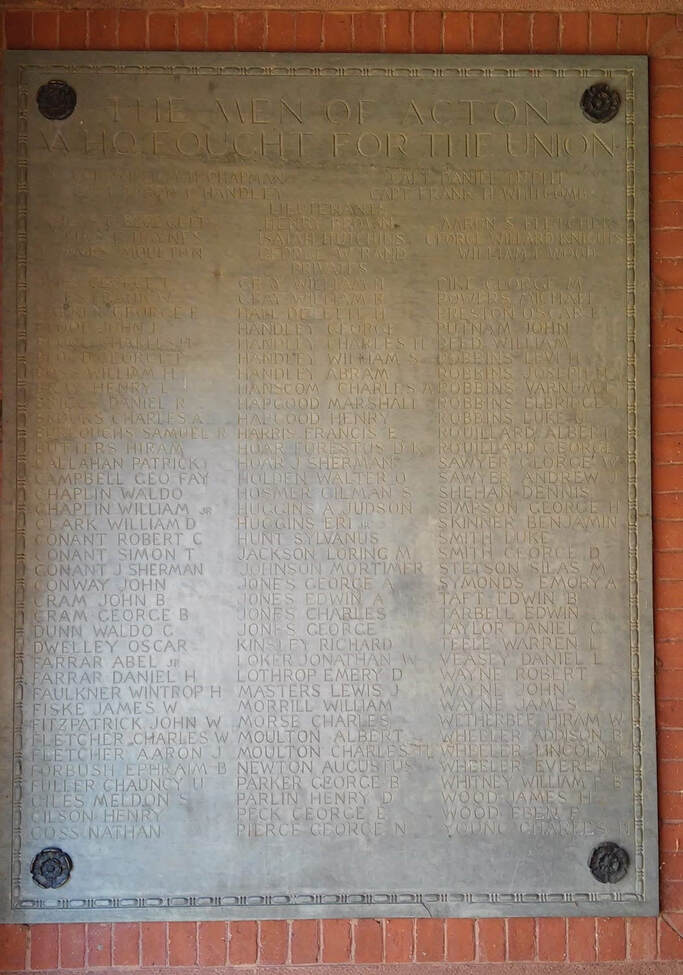
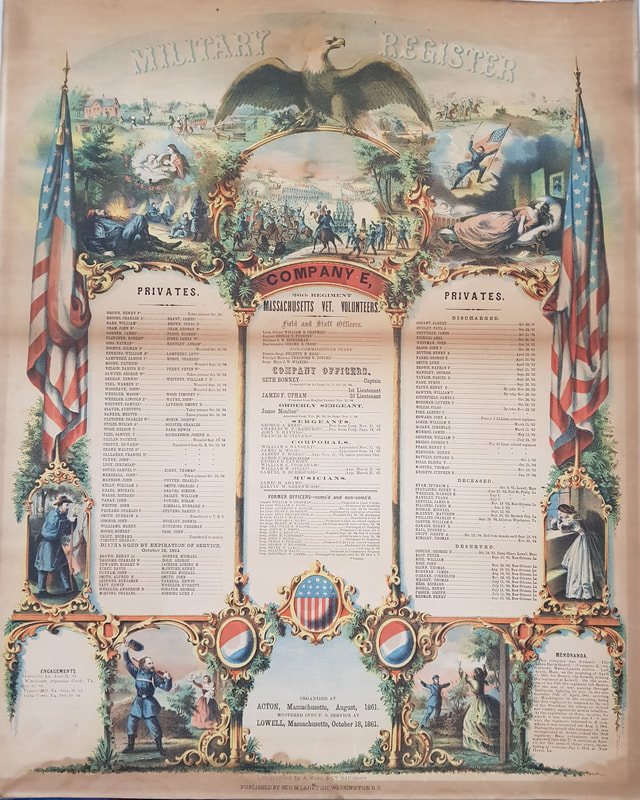
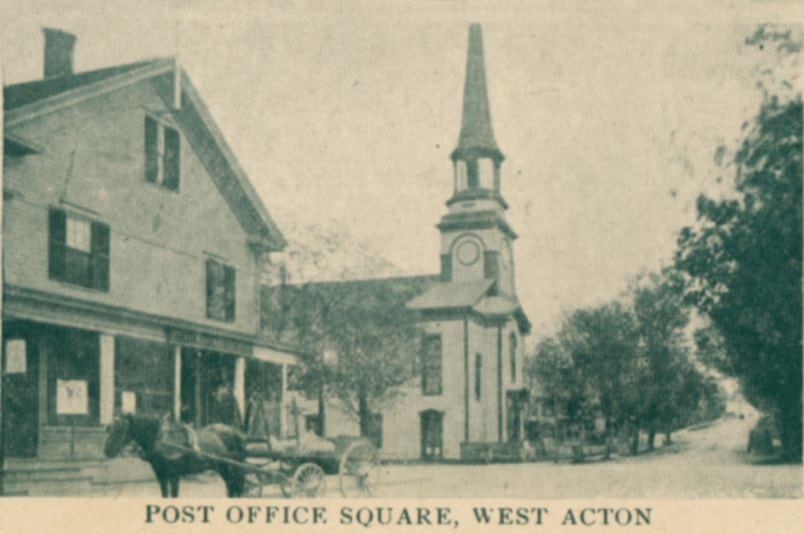
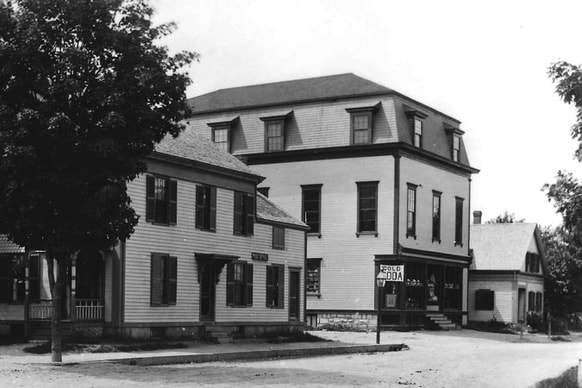
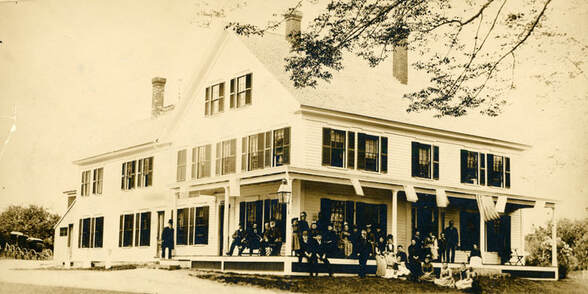


 RSS Feed
RSS Feed